The quaint town of Oberammergau, Germany is best known for three things: a world-famous Passion Play, a centuries-long tradition of woodcarving, and its elaborately painted buildings.
Oberammergau is situated in a scenic valley and is surrounded by the forested mountains of the Ammergau Alps, meaning that it’s also a paradise for nature-lovers.
It’s a community where time sometimes feels frozen, and where modern life meets the traditional. As a result, you’re likely to spot some residents dressed in colorful folk costumes when a local holiday rolls around. (Think Lederhosen, feather-adorned hats, and Dirndls.)
For more than seven years, my parents have called Oberammergau home. As a result, Shawn and I have spent many months getting to know Oberammergau, or “O’gau” as we call it. Along the way, we’ve soaked up some of the town’s history, done a bit of hiking, and gone on the hunt to find Oberammergau’s prettiest painted buildings.
Whether you’re coming to Oberammergau for the Passion Play, or simply to appreciate the ambience of this traditional Bavarian town, I’ve created this Oberammergau guide for you.
It highlights Oberammergau’s main attractions, as well as popular outdoor activities. It also includes general information that will help you with everything from finding a hotel to shopping for souvenirs. Finally, if you decide to base yourself in Oberammergau, I’ve also shared a few day-trip ideas for you to consider.
This is an in-depth post, but you can easily navigate it by using the Table of Contents.
Also, please note that some of the sites which I reference are actually in German. Unfortunately, there isn’t a wealth of English-language information available on the internet about the area. However, the German-language websites can easily be translated using Google Translate.
Table of Contents
General
- Bakeries, Cafés, and Restaurants
- Events and Festivals
- Hotels and Accommodation
- Language Basics
- Map of Oberammergau
- Money and Tipping
- Oberammergau’s History
- Passion Play
- Pharmacies
- Post Offices
- Printing Documents
- Souvenirs and Shopping
- Supermarkets and Special Dietary Needs
- Tourist Information Office
- Transportation
Attractions
- Crucifixion Monument (Kreuzigungsgruppe)
- Döttenbichl Hill Battle Site
- Hansel and Gretel House (Hänsel und Gretel Haus)
- House of Pontius Pilate (Pilatushaus)
- Little Red Riding Hood House (Rotkäppchen Haus)
- Oberammergau Museum
- Painted Buildings (Bavarian Lüftlmalerei Frescoes)
- Passion Play Theater and Museum (Passionstheater)
- Saint Peter and Paul Church (Pfarrkirche St. Peter und Paul)
- Woodcarving Tradition
Outdoor Activities
- Alpine Coaster (Rodelbahn)
- Altherrenweg / Romanshöhe
- Aufacker Mountain
- Biking
- Cross-Country Skiing (Longlauf)
- Ettaler Weidmoos Nature Preserve
- Hiking
- Kofel Mountain
- Laber Mountain
- Rock Climbing
- Stroll Along the Grosse Laine and the Ammer Rivers
- Swimming (WellenBerg Pool)
- Wild-Deer Feeding (Wildtierfütterung)
Day Trips from Oberammergau
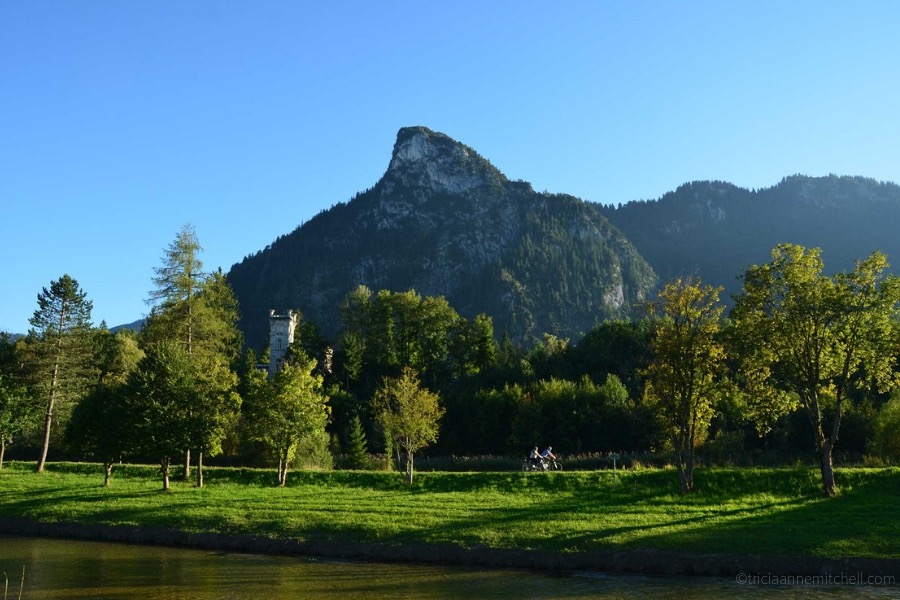

Oberammergau’s History
Not much is known about Oberammergau’s earliest history. However, the area is believed to have once been inhabited by the Celts. The Celts might even have given Oberammergau, as well as its river, the Ammer, their names. (It’s thought that both names are derived from the Celtic name “Ambrigo” as well as the Celtic word for river — “Ambara” or “Ampra.”)
In the 1330s, Emperor Ludwig the Bavarian ruled over the region. He founded the nearby Ettal Monastery, and he gave Oberammergau residents special privileges — such as the right to transport goods along the lucrative trade route linking Venice with the southern German city of Augsburg.
Thanks to its forested surroundings and plentiful supply of wood, many Oberammergau residents took to woodcarving. Oberammergau’s special trading privileges allowed the village’s woodcarvers to market their wares around Europe.
In the early 1630s, the plague ravaged much of the region. While Oberammergau initially escaped the worst of this wave of the “Black Death” epidemic, the disease eventually made its way into the village. More than 80 villagers died.
In 1633, Oberammergau’s residents are said to have made a promise to regularly stage a Passion Play if the village was spared from the plague. According to tradition, no one else became sick, and in 1634, locals acted in Oberammergau’s first Passion Play. Over time, the village came to be known worldwide for this theatrical production.
Since the 19th century, Oberammergau has had ties with Ludwig II of Bavaria, the so-called “fairy tale king” or “mad king.” He attended the Passion Play in Oberammergau, and spent time in the nearby Linderhof Palace. Even today, Oberammergau locals still celebrate the eve of Ludwig’s birthday with an annual bonfire event.
These days, Oberammergau is part of Bavaria, Germany’s largest state. Oberammergau is even the subject of a tongue twister, which has been incorporated into a folk song and popular music.
More –
- Oberammergau vintage black & white photo series, in LIFE magazine (Google Arts & Culture)
- Fascinating old postcards and maps of Oberammergau (Wikimedia Commons)
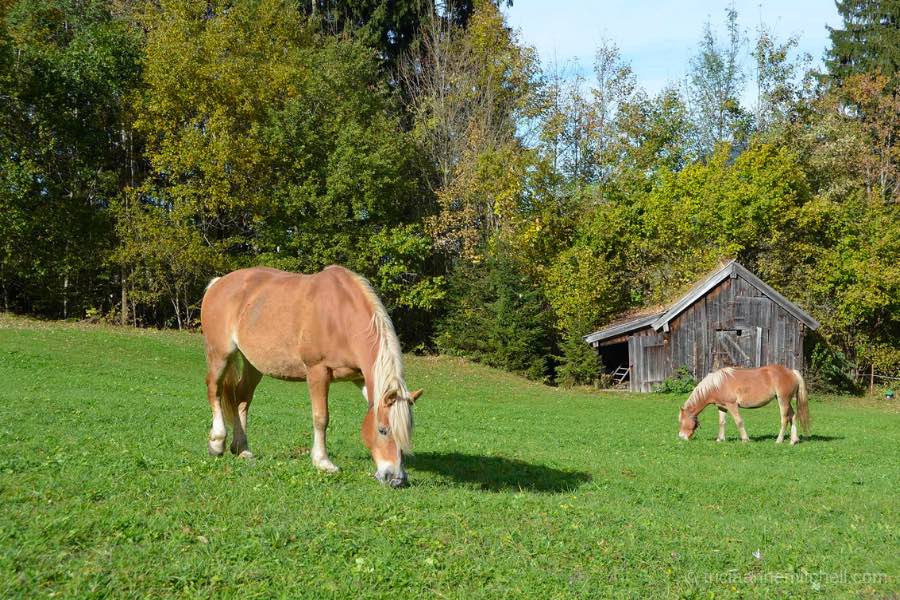
Painted Buildings With Lüftlmalerei Frescoes
Many of Oberammergau’s buildings are decorated with ornate frescoes called Lüftlmalerei. This painting style isn’t unique to Oberammergau. In fact, buildings in many villages of Upper Bavaria (Oberbayern) are adorned with this traditional style of painting.
The Lüftlmalerei painting technique gained popularity in the 18th century. Many homeowners wanted to demonstrate their wealth by having an elaborately decorated home. Even today, it’s still rather costly to hire an artist to paint your home with Lüftlmalerei.
Historians aren’t sure where the name “Lüftlmalerei” originated. It’s thought that it possibly developed from the way in which frescoes must be painted quickly before the air (Luft) dries the wet plaster.
Another theory is that the term Lüftlmalerei is somehow connected to Franz Seraph Zwinck, one of Oberammergau’s most famous Lüftlmalerei painters. (In the 18th century, Zwinck lived in a home named Zum Lüftl. It’s possible then, that locals referred to him as Lüftlmaler — literally the “Lüft painter.”)
As you stroll through Oberammergau’s streets, you’ll notice that religious scenes seem to be the most common designs on homes. However, you might find some walls decorated with pretty floral motifs — even scenes from popular fairy tales like Little Red Riding Hood or Hansel and Gretel.
Here are the addresses of some of Oberammergau’s most famous painted buildings:
- Forestry Office (Forstbetrieb), address: Ettalerstrasse 3
- Hansel and Gretel House, address: Ettalerstrasse 48
- Hotel Alte Post, address: Dorfstrasse 19
- Little Red Riding Hood House, address: Ettalerstrasse 41
- Ludwig Thoma Birthplace, address: Dorfstrasse 20
- Pilatushaus, address: Ludwig-Thoma-Strasse 10






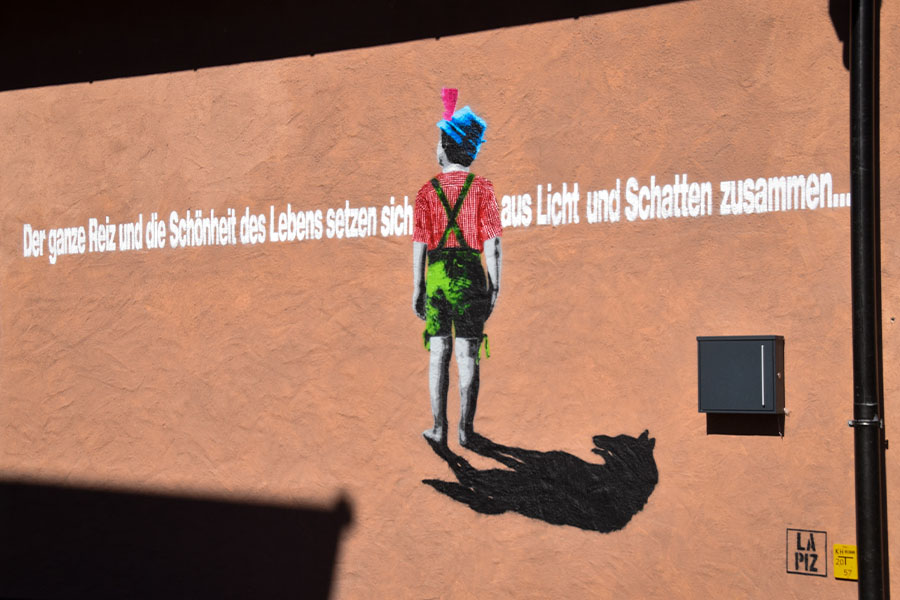
Hansel and Gretel House (Hänsel und Gretel Heim)
Address: Ettalerstrasse 41
Pass by the Hansel and Gretel House at almost any time of day and you’re likely to see tourists snapping pictures of this much-beloved Oberammergau building. Like the fairy tale upon which it’s based, the building’s scenes have some unpleasant elements. You’ll spot children kept in cages, and Gretel triumphantly shoving the evil witch into an oven. Thankfully, there are also more cheery scenes, such as the children being reunited with their parents.
A few captions are written on the walls in old-fashioned script called Gebrochene Schrift. The building is finished off with green shutters, as well as flower boxes overflowing with colorful blooms — or snow — depending upon when you visit.
Oberammergau’s wood-carving school was originally housed in the Hansel and Gretel House’s two interconnected structures. However, in 1926, an orphanage was established here. You’ll also see this building referred to as the Marie-Mattfeld-Haus. That’s because a German-American opera singer named Marie Mattfeld raised the funds needed to establish child-welfare programs here. Today, the Marie-Mattfeld complex is no longer an orphanage, but it still provides youth-welfare services. Several of the neighboring buildings are part of this social program.
More –
- Marie-Mattfeld-Haus (official website)


Little Red Riding Hood House (Rotkäppchen Haus)
Address: Ettalerstrasse 48
The Little Red Riding Hood House is just across the street from the Hansel and Gretel House. Like its neighbor, the building is adorned with fairy tale scenes. Nestled between the building’s gable, balcony, and windows are Little Red Riding Hood, her grandmother, the ravenous wolf, the heroic woodcutter, and Little Red Riding Hood’s mother. Both Little Red Riding Hood and Hansel and Gretel were written by the Brothers Grimm.
Oberammergau’s famous peak, the Kofel, towers over the building, making for a charming photograph. However, because of the building’s orientation (it’s east-facing), the lighting isn’t ideal for afternoon photography. Try to arrive in the morning, if possible.
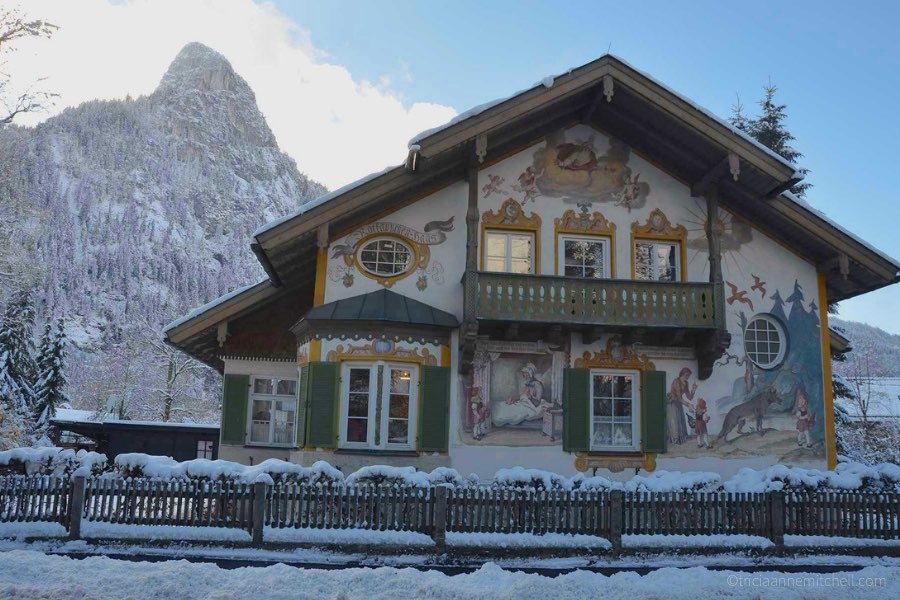
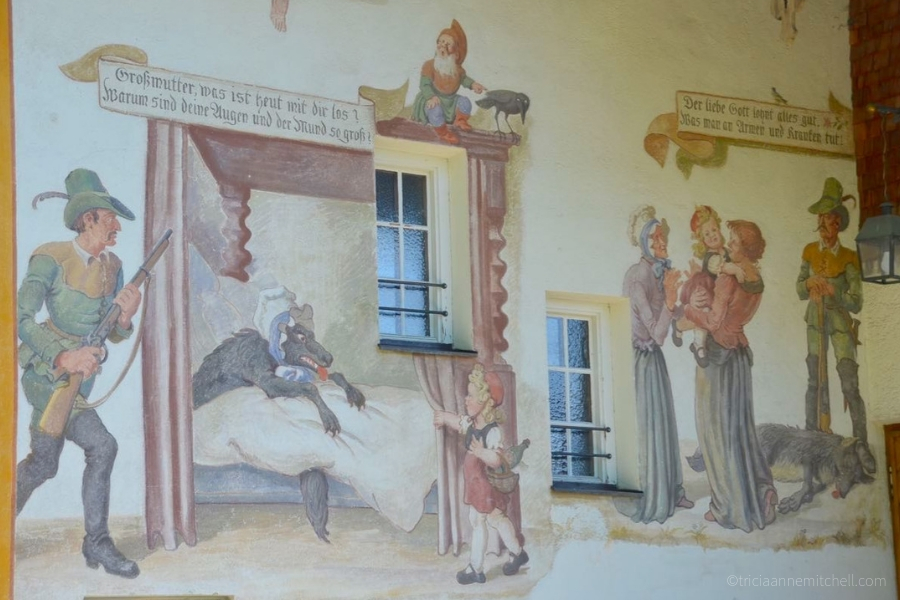

Saint Peter and Paul Church (Pfarrkirche St. Peter und Paul)
Address: Frühmessergasse 1
Oberammergau’s earliest Catholic church was a wooden structure, however, it was eventually damaged beyond repair. The Rococo-style building you see today was built in the 18th century.
According to some accounts, locals made their 1633 Passion Play vow by one of the crosses housed inside the Saint Peter and Paul Church. You can see the cross in the center of the altar that’s on the right side of the church.
On the church grounds there is an atmospheric cemetery that’s worth walking through. Many of the grave markers are elaborate and carved out of wood. Some headstones even include a weathered black and white image of the person buried there.
On the church’s southwest side is a war memorial. It lists the names of Oberammergau residents killed during several wars, including World War I.
More –
- Saint Peter and Paul Church History (official website)



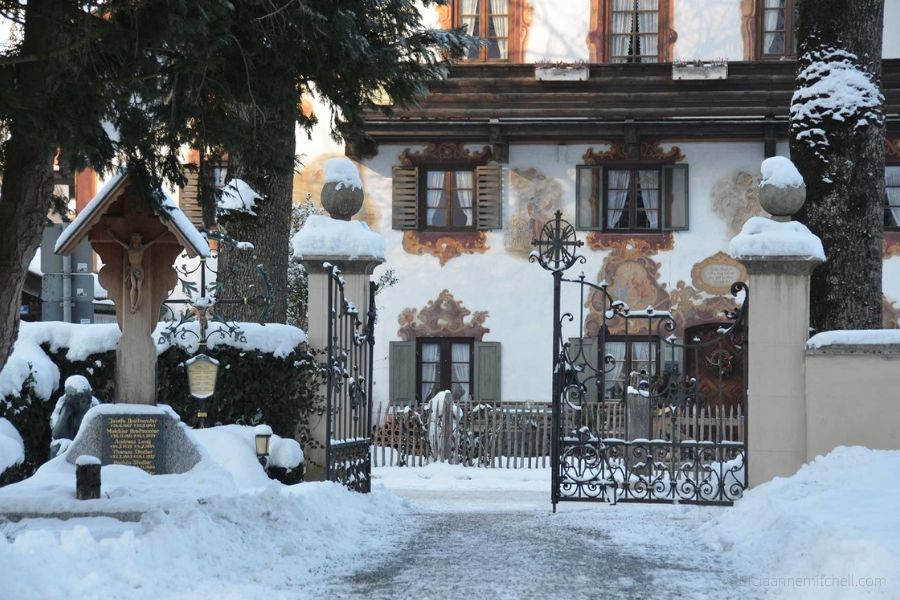


Passion Play Theater and Museum (Passionstheater)
Address: Theaterstrasse 16
Every ten years, Oberammergau stages a Passion Play. This production depicts the life of Jesus and attracts hundreds of thousands of visitors from around the world. Some attendees are religious pilgrims, while others are merely curious visitors interested in the play’s long and storied history.
The inhabitants of Oberammergau are said to have put on a Passion Play (Passionsspiele) since 1634. One year earlier, Oberammergau’s residents made the pledge to stage a play regularly, if God spared Oberammergau from additional bubonic plague deaths.
Initially, the plague had only ravaged neighboring villages. Oberammergau, however, had been able to keep the infectious disease at bay by controlling who entered and left the village. But eventually, a resident named Kaspar Schisler snuck back into Oberammergau and brought the plague with him. He had been working in the nearby village of Eschenlohe, and is said to have wanted to visit his family. About 80 Oberammergau residents died from the plague, prompting the residents to make the Passion Play pledge. According to Oberammergau legend, no additional residents died once the pledge was made.
What makes Oberammergau’s Passion Play remarkable is that almost half of the city’s 5,000-strong population participates in the production. From actors and musicians to directors and vocalists, Oberammergau residents fill all the roles. In the year or so leading up to the play, male actors are required to grow out their hair and their beards; as a result, you can speculate about who is and isn’t participating in the play based upon how cleanly shaven they are.
In order to qualify for the Passion Play, you have to have lived in Oberammergau for at least 20 years. If you marry a local, that time requirement is halved. In the past, women couldn’t participate if they were over the age of 35, or if they were married. That restriction was successfully challenged by several women who took the case to the Bavarian Constitutional Court.
Throughout the centuries, many famous and infamous personalities have attended Oberammergau’s Passion Play, including King Ludwig II, Dwight Eisenhower, Henry Ford, Adolf Hitler, and royals from Greece and Thailand.
The 2022 Passion Play (which was supposed to take place in 2020, but postponed because of the COVID-19 pandemic) was Oberammergau’s 42nd since 1634. In total, about 102 performances were presented throughout the year.
Oberammergau built a special building for the play, and it is said to be one of the world’s largest open-air theaters. The Passion Plays weren’t always held in this theater, though. In fact, back in 1634, the first performance took place in the graveyard next to Oberammergau’s Catholic church. In 1830, the production was moved to the north side of Oberammergau.
These days, the Passion Play is held in years ending in zero. During off-years, operas and other theatrical performances take place in the theater. Oberammergau’s next Passion Play will take place in 2030.
It’s also possible to tour the Passion Play Theater.
More –
- Passion Play 2030 (Official website for buying Passion Play tickets)
- Passion Play Theater (Official website)
- Passion Play Theater Tours (official website) lists ticket prices & opening hours
- Passion Play Historical Timeline
- Oberammergau’s Passion Play Evolves to Shed Its Dark Legacy (Financial Times)
- Of Beards and Bubonic Plague: German Village Prays for a (2nd) Miracle (New York Times)
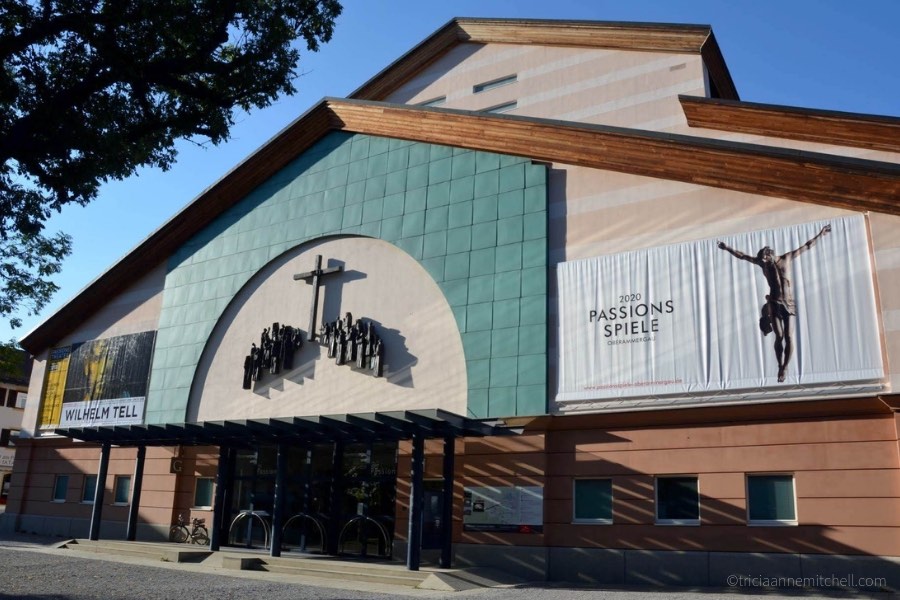

Oberammergau’s Woodcarving Tradition
For centuries, Oberammergau has been celebrated for its woodcarvers (Herrgottschnitzer) and their fine creations. Even today, there are more than 60 woodcarvers in town — meaning that you have many opportunities to bring home a wooden souvenir from Oberammergau.
Oberammergau was once on a lucrative trade route that linked the southern German city of Augsburg with Venice. Back then, wandering merchants called Kraxenträger donned backpack-like contraptions on which they carried wooden objects for sale. You’ll see depictions of these merchants throughout Oberammergau. Some are in sculpture form, while other Kraxenträger are featured in murals painted on buildings. (One of the finest paintings is on the western side of the Hotel Alte Post.)
Just outside of Oberammergau’s city center is the Vocational School of Wood Sculptors (Schnitzschule, or Staatliche Berufsfachschule für Holzbildhauer und Schnitzer). This learning center has been around for almost 140 years. The school sometimes puts on exhibitions, which are open to the public. Its address is: Ludwig-Lang Strasse 3.
More –
- Bavaria’s Wood-Carvers Struggle to Keep Tradition Alive (DW article)
- Oberammergau’s State Vocational School for Wood Sculptors Staatliche Berufsfachschule für Holzbildhauer (Official Website)
- Video About the Carving School in Oberammergau (YouTube video)

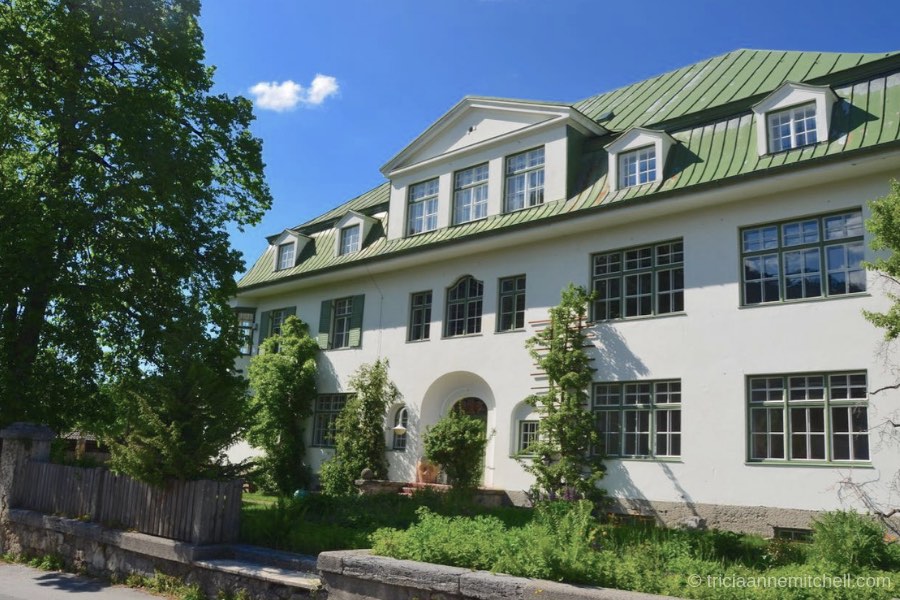

Döttenbichl Hill Battle Site
Address: Döttenbichl Hill
Around 15 BCE, a legion of Roman soldiers and the Räter, an alpine tribe, fought a massive battle in what is now Oberammergau. These groups clashed on or near the Döttenbichl, a hill to Oberammergau’s south. With their sophisticated equipment, the 19th Legion swiftly defeated the Räters.
It wasn’t until the 1990s that archaeologists unearthed hundreds of metal artifacts from this battle on the Döttenbichl. They found Celtic brooches, as well as iron tools. They also discovered Roman coins, daggers, shoe nails, and arrowheads. Historians think that the Döttenbichl was a sacred place for the Räter before and even after the battle in 15 BCE. They also believe that those Räter who survived the battle assembled metal objects on the Döttenbichl, and burned them in a ritual fashion to make an offering to their gods.
Some of the artifacts from this battle — including shoe nails, arrowheads, and a replica of the dagger — are on display at the Oberammergau Museum.



House of Pontius Pilate (Pilatushaus)
Address: Ludwig-Thoma-Strasse 10
The Pilatushaus was built in the 1770s. It boasts impressive trompe-l’œil frescoes that give the impression that you are looking at a three-dimensional scene. These paintings were originally created by Franz Seraph Zwinck, one of Oberammergau’s most famous painters.
The Pilatushaus also showcases local arts and crafts. Inside, on the building’s ground floor, you can watch regional artisans as they practice their crafts. These exhibitions are called the Lebenden Werkstatt (or living workshop). Exhibits vary, but in the past, reverse glass painters, woodcarvers, coppersmiths, pottery makers, and jumping-jack makers have exhibited here.
When the Lebenden Werkstatt is taking place, it’s possible to chat with the artisans and purchase their handmade work. There is no fee to enter the Lebenden Werkstatt exhibition, and you can enter via the garden on the south side of the Pilatushaus.
Upstairs is the Welten Hinter Glas exhibition (World Behind Glass). It features one of Europe’s largest collections of reverse-glass paintings. This artform was especially popular from the 16th to 19th centuries.
More –
- Pilatushaus History (Ammergauer Alps Tourism website)
- Lebenden Werkstatt (lists opening hours of the Living Workshop)
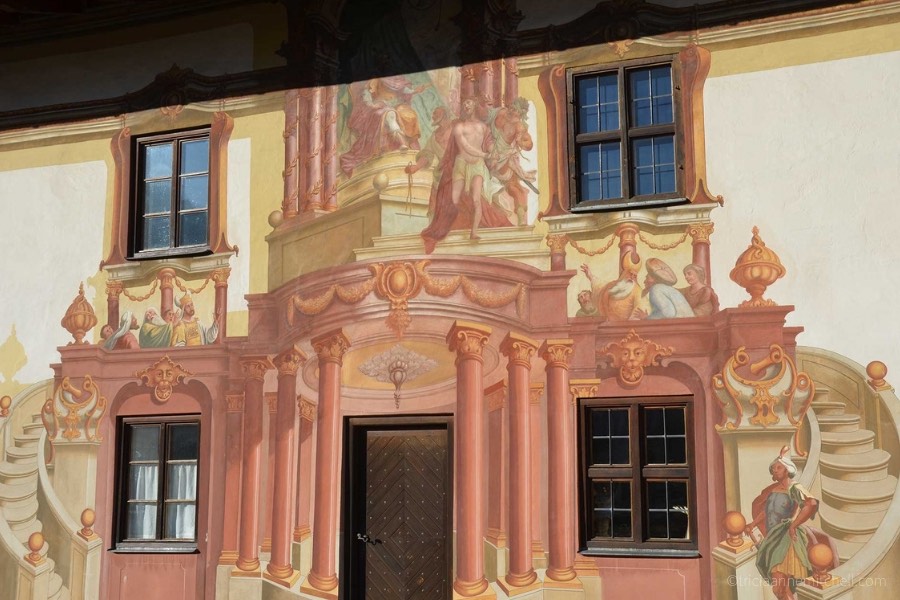
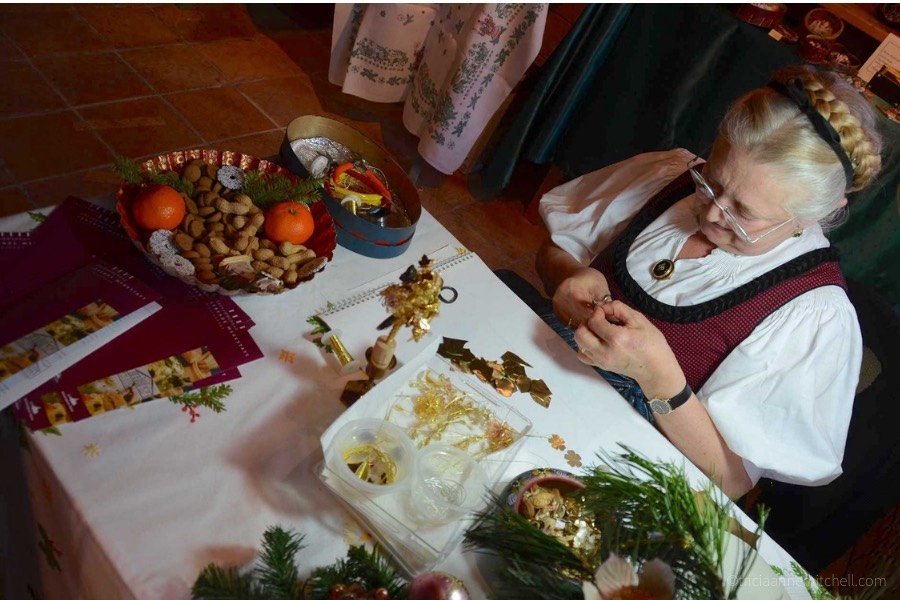


Oberammergau Museum
Address: Dorfstrasse 8
The Oberammergau Museum is home to a diverse collection, including nativity scenes, hand-carved toys, and ancient Roman artifacts.
One section of the museum is devoted to several nativity scenes. The most famous nativity scene took more than a century to complete. Piece by piece, Oberammergau woodcarvers progressively contributed figures to the scene. Eventually, there were about 200 figures.
Elsewhere you’ll find a large collection of wooden toys, including doll heads, jumping jacks (Hampelmänner), and figurines of animals and soldiers.
You’ll also see Roman artifacts unearthed from Oberammergau’s Döttenbichl Hill in the 1990s. Nearby, around 15 BCE, a massive battle was fought between the Räter (a local tribe) and the 19th Legion. A Roman dagger, arrowheads, and nails from Roman sandals are all on display.
A reproduction of a vintage living room, coupled with crucifixes and more woodcarvings, rounds out the museum’s collection.
More –
- Oberammergau Museum (official website) lists opening hours & entrance fees.
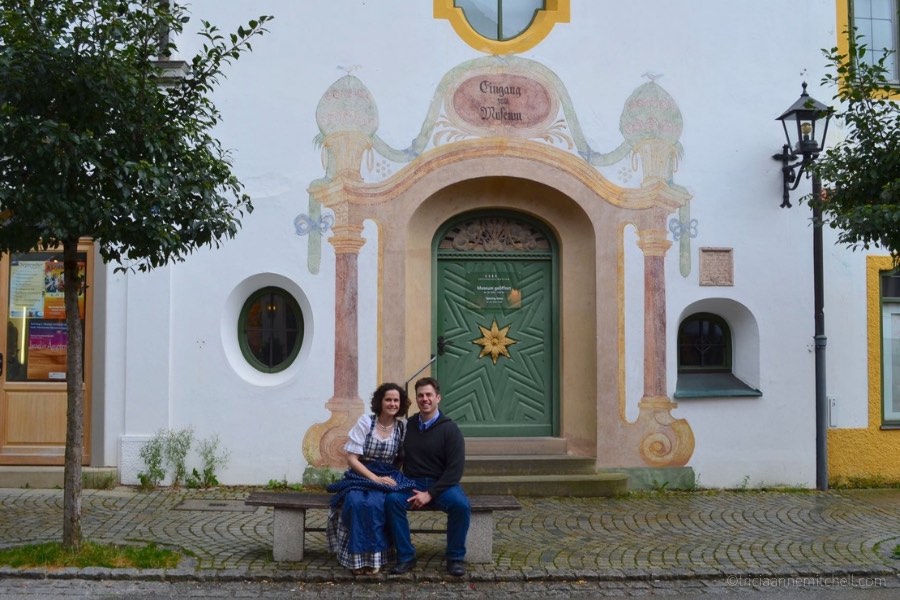



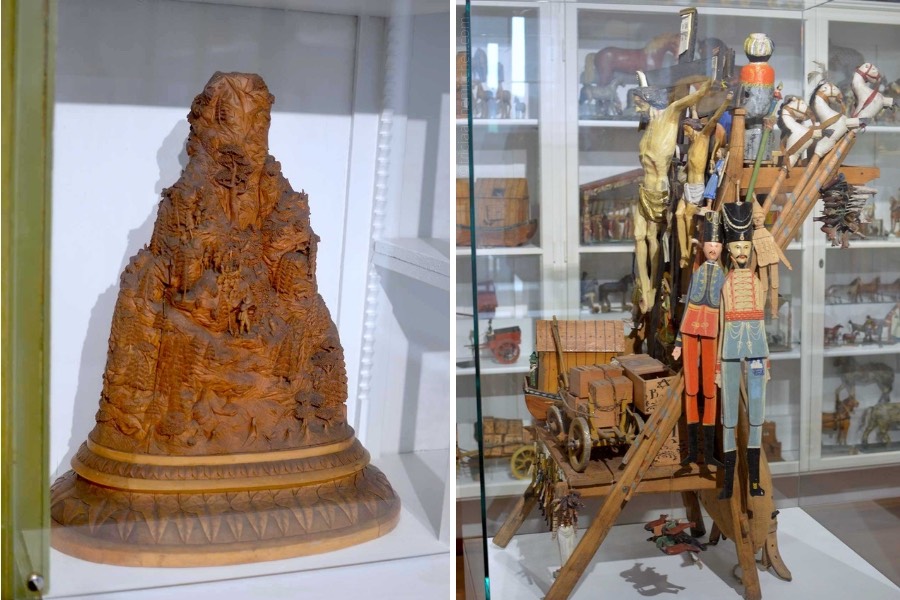
Crucifixion Monument (Kreuzigungsgruppe)
Address: König-Ludwig Strasse 44
The Crucifixion Monument (Kreuzigungsgruppe) is a marble statue that was donated to Oberammergau by King Ludwig II. The king gave the statue to express his thanks for a private Passion Play performance that Oberammergau held in his honor in 1871.
The statue was unveiled in 1875. At the time, it was the largest statue of its kind, weighing 58 tons.
Oberammergau’s Crucifixion Monument is located on the Osterbichl Hill.


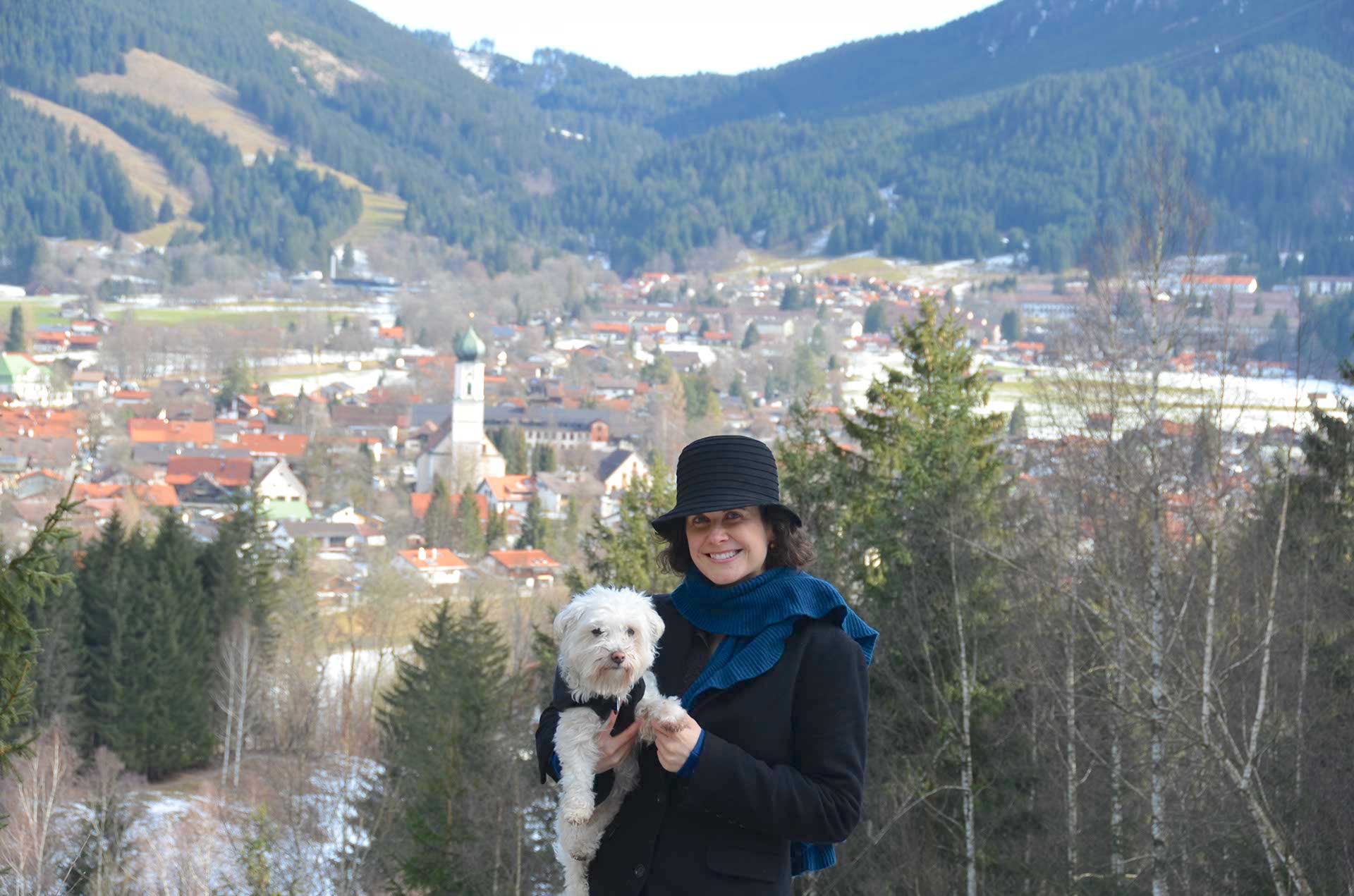
Outdoor Activities
Thanks to its idyllic natural surroundings, Oberammergau offers a wide range of outdoor activities. There’s everything from hiking and biking to cross-country skiing and paragliding possibilities. Keep scrolling for more details.

Alpine Coaster (Rodelbahn)
Address: Kreislainenweg (on the Kolbensattel)
If you’re in the mood for a bit of exhilaration, look no further than Oberammergau’s alpine coaster. This summertime “toboggan run” is 2.6 km (1.6 miles) long and is located on the slopes of the Kolbensattel.
The track features more than 70 curves, plus a few jumps. By the time you get to the end, you will have descended about 400 meters (1,312 feet). If you’re like me, you will have screamed a bit, too.
Speeds are maxed out at 40 kilometers per hour (25 miles per hour), and you can control the brakes yourself. Shawn and I rode down together, as did my parents. As brake-master, Shawn loved teasing me by going as fast as we could for much of the race down into the valley.
To get to the starting line of the alpine coaster’s track, you have two options. You can hike up yourself. Or, you can hop onto the Kolbensattel chair lift, which will take you on a scenic ride high above evergreen trees, wildflowers, and ferns. As you get higher up the mountain, you’ll also see Oberammergau’s red rooftops and the forested mountains cradling the village. We opted for the chair lift, but if you have the time, I think it’d be a beautiful hike.
It’s worth spending a bit of time up on the Kolbensattel before jumping onto the alpine coaster. The views up there are extraordinary, and there’s a playground. A restaurant housed in a rustic lodge serves up everything from coffee and beer to soup and sausages. This is also a good launching point for summertime hiking and biking adventures. In the winter, the mountain’s slopes attract skiers.
This Kolbensattel webcam offers a live glimpse what what it’s like up on the mountain.
More
- Kolbensattel Alpine Coaster (official website) lists opening hours & fees
- Curvy Exhilaration: Riding the Alpine Coaster in Oberammergau, Germany (my blog post & Shawn’s video)

Biking
With dedicated biking trails, and lesser-traveled secondary roads, Oberammergau is a paradise for cyclists.
German trains make it easy to bring your own bike with you. Some hotels and holiday apartments even offer complimentary bikes.
Finally, you can rent bikes in Oberammergau, too. Be on the lookout for signs that say Fahrradverleih, which means “bike rental.”
More –
- Bike Rentals in Oberammergau: According to the Ammergauer Alps Tourism website, there are several shops in Oberammergau that rent bikes and biking accessories such as helmets, bike trailers, and children’s seats. As of 2022, Sport-Zentrale Papistock was renting e-bikes and mountain bikes for about 29€ per day. Likewise, Drahtesel-Verleih Lukas Spindler was charging upwards of 20€ for a half-day rental. In early 2022, my husband and I rented a city bike from Sport-Zentrale Papistock and rode to Schloss Linderhof (Linderhof Palace). We were happy with the bike and would rent from there again.
- Bike Repairs in Oberammergau: My parents and I have had bike repairs and check-ups done at Radsport Lang (in Oberammergau) and 2Radstadl (in nearby Saulgrub-Wurmansau). We were pleased with the service at both bike shops.
- Cycling Tips (Ammergauer Alps Tourism website) – suggests a few biking routes and details the length, level of difficulty, and what you’ll see along the way.

Cross-Country Skiing (Longlauf)
With an abundance of snow and stunning winter surroundings, Oberammergau is a popular destination for cross-country skiers. Every winter, Oberammergau plays host to the König Ludwig Lauf, one of Germany’s most important cross-country skiing events. In keeping with its namesake (the race is dedicated to King Ludwig), the participants race through the grounds of Ludwig’s Linderhof Palace before reaching the finish line in Oberammergau.
You needn’t be a world-class athlete to enjoy the area’s 180 kilometers (112 miles) of well-groomed trails, as there are many accessible routes available.
More –
- See this Ammergauer Alpen Cross-Country Trail Map for routes that cut through Oberammergau, Unterammergau, Graswang, Ettal, Altenau, Bad Kohlgrub, and Bad Bayersoien.

Hiking and Walking
Cradled by the foothills of the Alps, Oberammergau offers a variety of scenic walks and hikes. The paths on the valley floor near Oberammergau don’t have much of an incline, making for a more leisurely stroll.
Ascents to local mountains like the Kofel, Laber, or Aufacker, on the other hand, will have you making your way uphill for a few hours.
The trails in the Oberammergau area are generally well-signed. And since there are huts and eateries on many of the routes, you can even stop and enjoy a drink or meal to celebrate your physical accomplishment.
Here are a few of Oberammergau’s great walks and hikes:
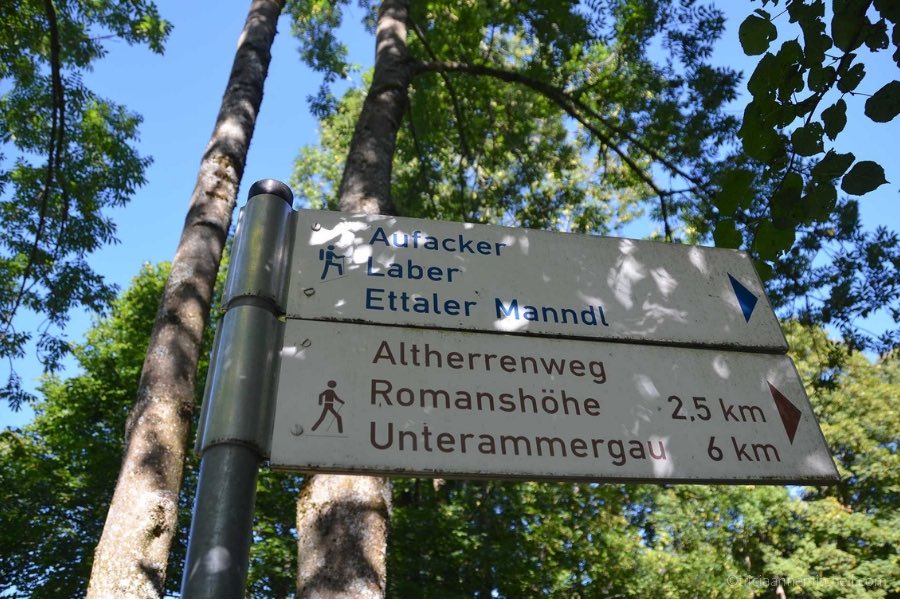
Altherrenweg / Romanshöhe
If you’re looking for a gentle climb coupled with superb views of Oberammergau, then the Romanshöhe path is the walk for you.
The WellenBerg Pool is a good starting point for this walk. As you gain a bit of elevation, you’ll be rewarded with extraordinary views of Oberammergau’s “skyline,” as well as the mountains that tower over the town. On one section the path, you’ll pass a series of rustic and poignant wooden sculptures. From the sculpture of an infant to one of an older man with a cane, the woodcarvings depict the passage of time.
On the path you’ll find the Berggaststätte Romanshöhe, a small guesthouse. This chalet-style restaurant serves up hearty Bavarian dishes and splendid views from its terrace.


Stroll Along the Grosse Laine and the Ammer River
If you’re looking for a pleasant stroll near — but not in — the town center, you’ll want to check out the paths along the Grosse Laine and Ammer River.
The Grosse Laine path is open to pedestrians and offers calming views of the hills. Since the path parallels the tiny Laine River, you’ll be able to hear the soothing sound of water as it rushes down from the hills. Cyclists are not supposed to ride here.
The crushed rock path along the Ammer River, on the other hand, is open to pedestrians and cyclists. You’re likely to also spot horseback riders along the path. From here, you’ll take in great views of Mount Kofel and of the surrounding hillsides.
Both the Grosse Laine and the Ammer River walks are dog-friendly. There are even “dog toilets” along these two paths. These green garbage bins also dispense plastic bags for picking up dog droppings.

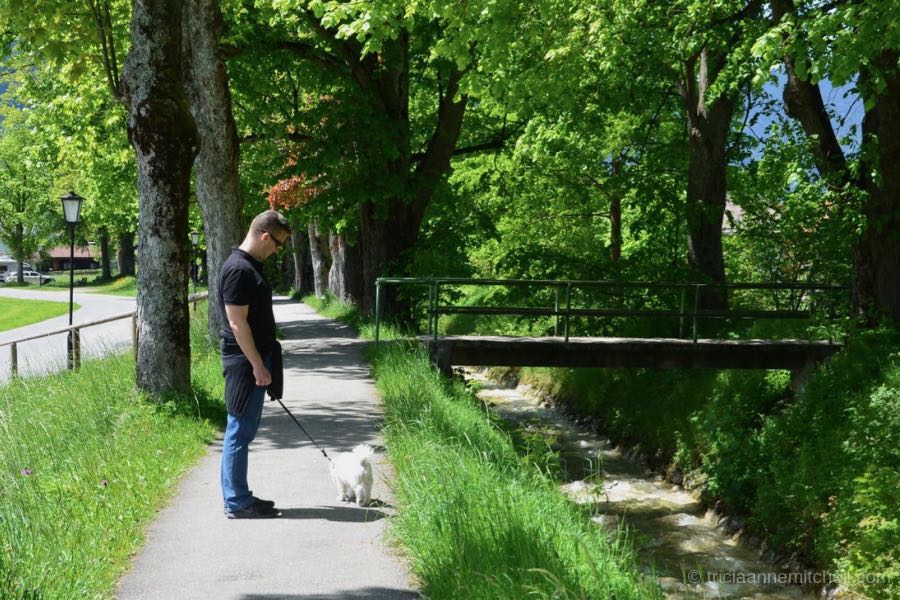

Ettaler Weidmoos Nature Preserve
The Ettaler Weidmoos is a pristine nature preserve, which is known for its beautiful spring and summer flowers. In the autumn months, the surrounding hillsides are dressed in fiery-orange and yellow hues. Once you’re in the Weidmoos, you might even see birch trees felled by beavers making dams and lodges.
From Oberammergau, it’s an easy walk or bike ride to the Weidmoos. You start your walk along the Ammer River, up into the forest past the Dottenbichl Battle Site, and past the Klettergarten Frauenwasserl rock-climbing area.
More –
- Hike Through the Weidmoos (Ammergauer Alps official tourist website)



Kofel Mountain
Thanks to its distinctive shape, the Kofel is arguably Oberammergau’s most beloved mountain. You’ll see the Kofel’s likeness painted on several of the town’s murals, and it’s even worked into some business names.
Every August, the Kofel is the epicenter of bonfire celebrations held to commemorate the birthday of Bavaria’s King Ludwig. Oberammergau men carry timber to the Kofel’s summit days before this event. Then, on the eve of Ludwig’s birth, they set the wooden crown on fire — much to the delight of people watching from below.
The first time I saw the Kofel’s sheer-looking front, I wondered how casual hikers could possibly make it to the top without special equipment. It turned out that it’s relatively straightforward to climb — it’s just at the top where things feel a bit precarious if you’re not fond of heights. Here, you’ll need to hold on to a metal cable.
Once you reach the summit (1342 meters or 4402 feet), you’ll be rewarded with fantastic views of neighboring peaks and Oberammergau in miniature.
More –
- Conquering the Kofel, Oberammergau’s Signature Mountain (my blog post)





Laber Mountain
Cable Car Address: Ludwig-Lang Strasse 59
At 1684 meters (5525 feet), the Laber is one of Oberammergau’s highest mountains. From the summit, the panoramic views are exceptional — especially on a blue-sky day. Owing to its incredible natural beauty, the Laber is popular with hikers, paragliders, skiers, and even diners.
To get to the top of the Laber you have two options: climb up, or ascend by cable car.
The easiest way, of course, is taking the cable car (Laber-Bergbahn). It is possible to purchase round-trip or one-way tickets. Buying a one-way ticket gives you the option to either walk up — or back down. Once you’ve made it to the top, you can enjoy a beverage (coffee, soft drinks, beer or wine), snacks, or a full Bavarian meal.
Near the cable car station at the Laber’s summit, informational boards highlight what peaks you’re seeing off in the distance. If the skies are clear, you’ll be able to see the Zugspitze, Germany’s highest peak.
Watching the paragliders take off from the top of the Laber is a popular activity. Standing on the steep slopes of the Laber, these adrenaline-seekers ready their fabric wings, run off the steep slopes, and then soar over the valley.
If you prefer to hike to the top of the Laber, there are a few trail possibilities. The trail on the north of the mountain is known to be steep. We instead hiked up via a road and a more-gradual trail that starts near the NATO School. This route took us underneath forested canopies to meadows full of grazing cows. As we worked our way to the top, we also trekked below the Ettaler Manndl and past the Soilasee, an alpine lake. Though this body of water dries up when the weather becomes warmer, it’s still impressive when filled with a carpet of green flora.
Aside from its natural appeal, the Laber also offers something for history buffs. During World War II, a top-secret research facility and an aircraft factory with the code name of “Cerusit” were housed inside the Laber. Nazi officials had part of the mountain’s base tunneled in order to obscure this project from the Allies. Hundreds of engineers were stationed in Oberammergau during this time.
The entrances to the complex have since been filled in with concrete. However, it’s still possible to walk by select sections and see evidence of this dark chapter of Oberammergau’s history.
More –
- Laber Cable Car (Laber Bergbahn) lists opening hours & ticket prices
- Laber Webcam — offers a live glimpse from the top of the mountain.
- Oberammergau NATO School (Hötzendorf Kaserne) History — includes an overview of the role the Laber played during World War II.



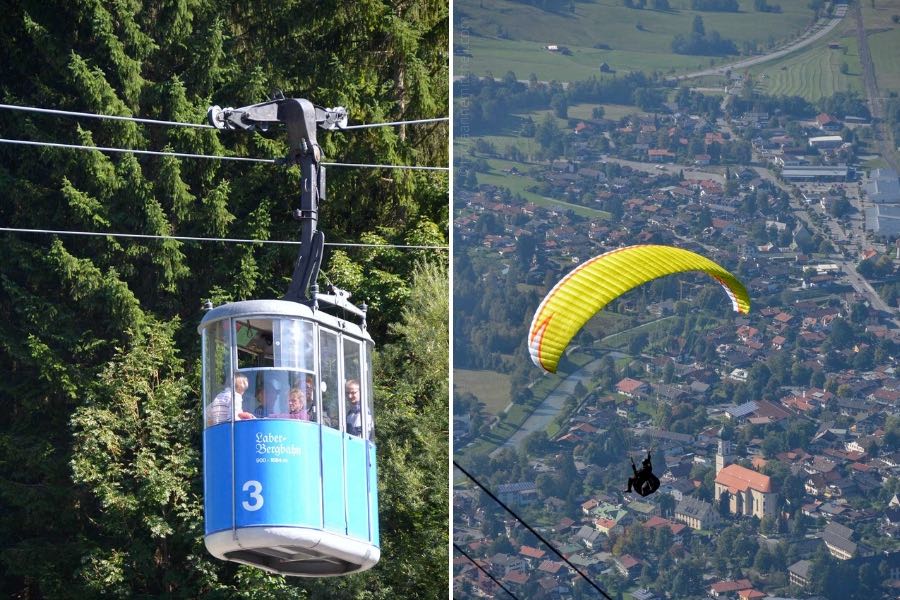


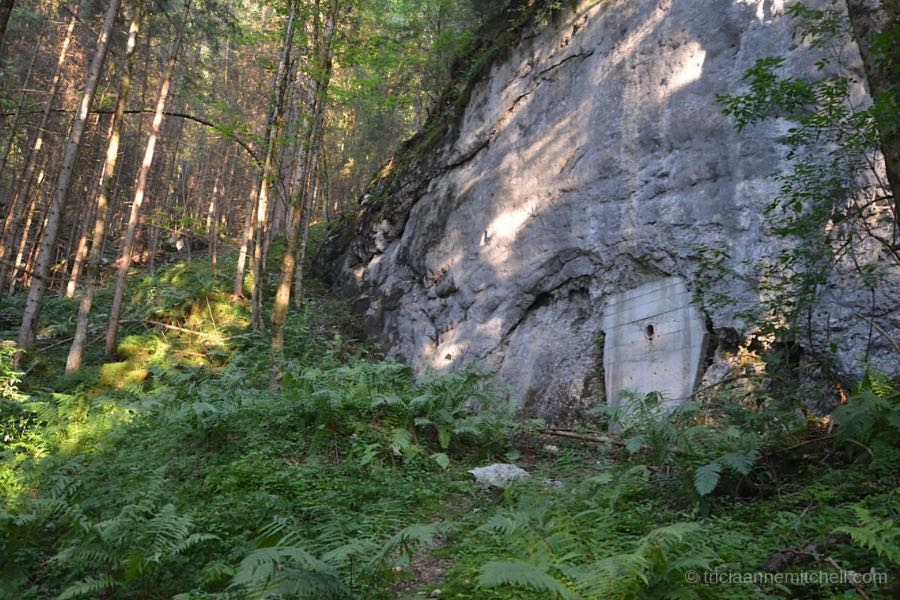
Aufacker Mountain
While the Laber and the Kofel mountains often get all the glory, the Aufacker also offers a pleasant hiking experience.
Much of the Aufacker’s trail is shaded, and it’s likely you’ll pass a herd of cows — perhaps even some mountain goats. The higher you climb, you’ll be rewarded with exceptional views of Oberammergau and the Kofel. At 1,542 meters (5,059 feet), the Aufacker is higher than the Kofel, too.





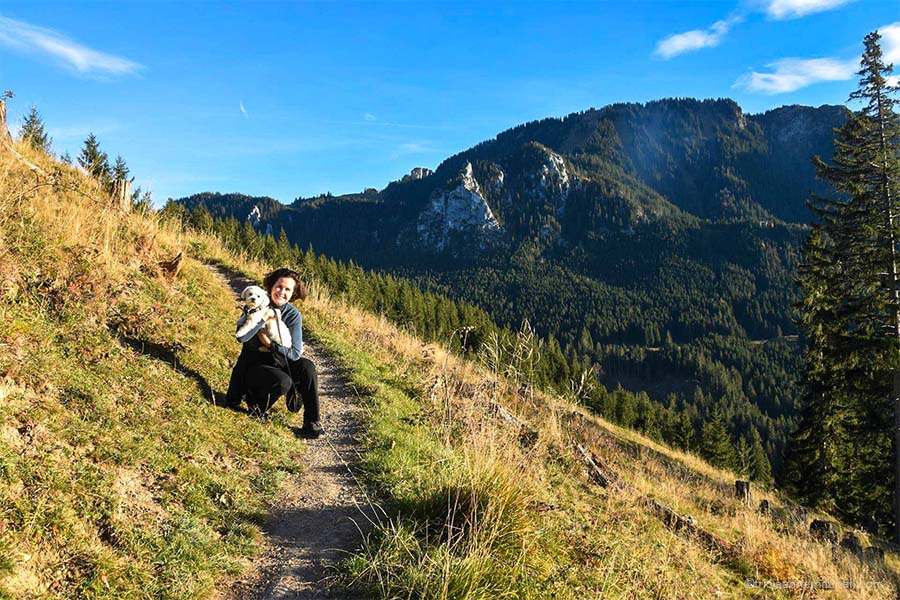
Swimming (WellenBerg Pool)
Address: Himmelreich 52
The WellenBerg swimming complex is located on the outskirts of Oberammergau, next to the Laine, a small river. Since the WellenBerg has indoor and outdoor pools, it’s possible to swim here year-round.
The facility’s outdoor pools have beautiful views of Oberammergau’s untouched hillsides. When it’s sunny, you can even sunbathe on the lawn.
Inside, there are several pools, two waterslides, and a sauna. There’s also an on-site restaurant, where you can feast upon everything from burgers and salads to sausages and snacks.
More –
- WellenBerg Pool (official website) lists opening hours and entrance fees

Rock Climbing (Klettern)
Located in the Ammer Mountains Nature Conservation Area, the Klettergarten Frauenwasserl Climbing Area is about 25 minutes away from Oberammergau on foot.
I’ve tried climbing indoors and outdoors when I lived in Heidelberg. However, I’ve never gone climbing in Oberammergau.
The Klettergarten Frauenwasserl is a popular climbing area. In fact, if the weather is favorable, I usually see climbers here whenever I’m walking or biking past this spot.
Even if you’re not into climbing, it’s fun watching the climbers brave the rocks here for a few moments!
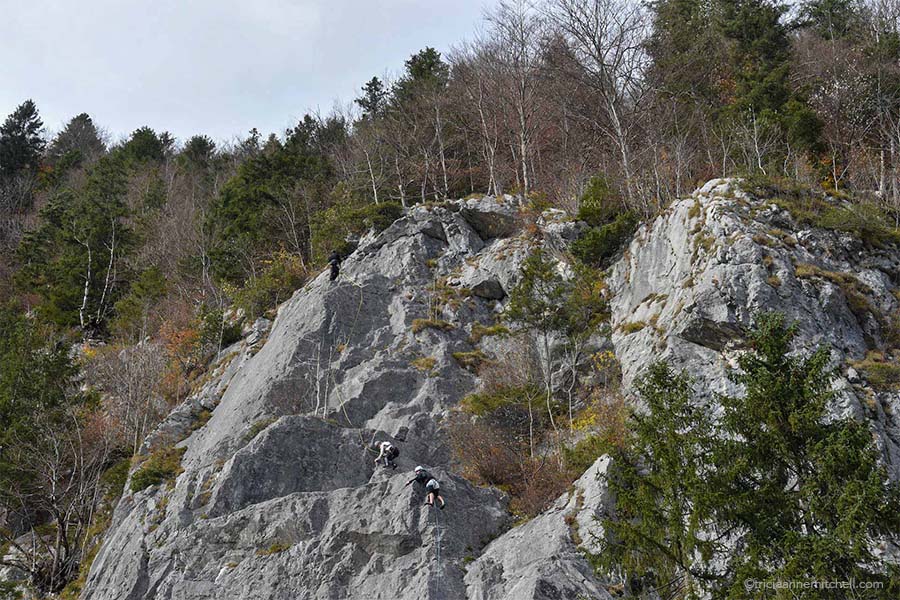

Wild-Deer Feeding (Wildtierfütterung)
Aside from skiing, are you wondering what to do in Oberammergau in the winter? If you’re an animal lover, be sure to check out a wild-animal feeding, which takes place in the nearby Graswang Valley.
During the winter months, Bavarian authorities help care for the deer inhabiting the forested mountains by offering them food. They do this to help the deer survive the winter, but also so they don’t devour too much forest foliage. Previously, the deer would have come into the valley to forage independently, but because some of their habitat has been developed by humans, the Wildtierfütterung is a necessary intervention.
When we attended a deer feeding a few years ago, about 50 deer came to the feeding stations! It was bitter cold — so be sure to dress appropriately if you go. All in all, it was a fun experience and worth the semi-frozen extremities.
Generally, the feedings are open to the public December through March.
More –
- Into the Forest: Watching a Wild Deer Feeding in the German Alps (my blog post & Shawn’s video)
- Wildlife Feeding Graswang (This Ammergauer Alps official tourist website lists the deer-feeding schedule, cost, and details of how to get there. This page is in German.)
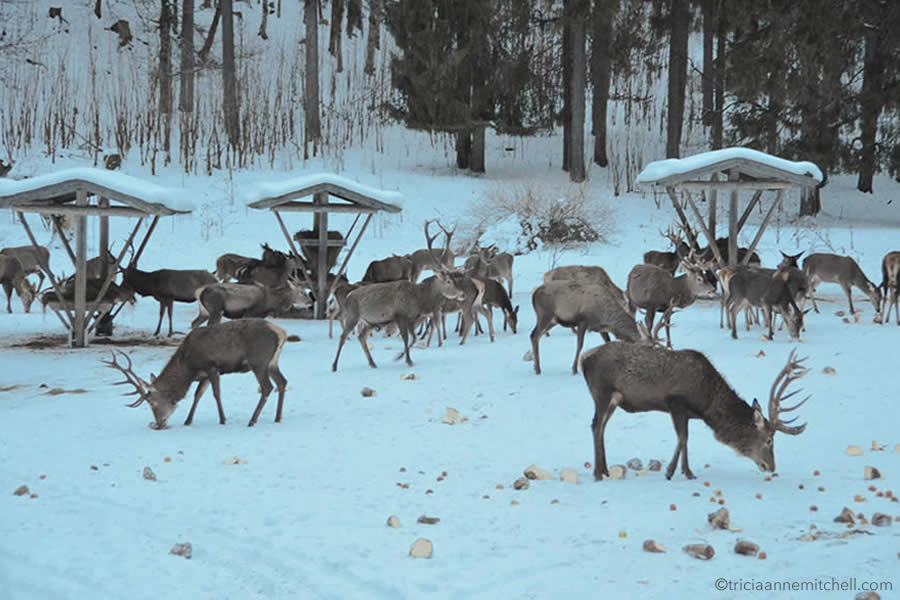
Passion Play
Oberammergau stages the Passion Play every ten years — in years ending in zero. The Passion Play was scheduled to take place in 2020. However, due to the COVID-19 pandemic, the Passion Play was postponed until 2022.
If you’d like to attend the Passion Play, you have several options. You can buy tickets for the Passion Play, and then make accommodation arrangements yourself. Or, you can purchase a package deal that includes accommodation, Passion Play tickets, and a few meals. Here are more helpful links:
- Passion Play Schedule & Performance Dates (Oberammergau’s official Passion Play website)
- Book Passion Play Tickets & Purchase Package Deals (Oberammergau’s official Passion Play website)
- Answers to Frequently Asked Questions (Oberammergau’s official Passion Play website)
Events and Festivals
From musical performances and nature walks to artisans demonstrating their skills, a variety of events take place in the Oberammergau area throughout the year. The Ammergau Alps Tourist Office website maintains a calendar of events, which is updated regularly.
- February: König Ludwig Lauf (Cross-Country Skiing Race)
- May and June: Gartenfeste (Folk-Dancing Festivals. To find the folk club’s events, click on Termine in the menu heading.)
- July: Heimatsound Festival (Festival featuring artists from Bavaria and the Alps)
- July to September: Outdoor Brass Band Concerts (performed by the Oberammergau Musikverein)
- 24 August: König Ludwig Feuer (King Ludwig’s Birthday Bonfire)
- 1st Sunday of December: Christkindlmarkt (Christmasmarket)
- 31 December: Sternrundgang (Star Procession on New Year’s Eve)
- Ongoing (during non-Passion Play Years): Varied Theatrical Performances at the Passion Play Theater

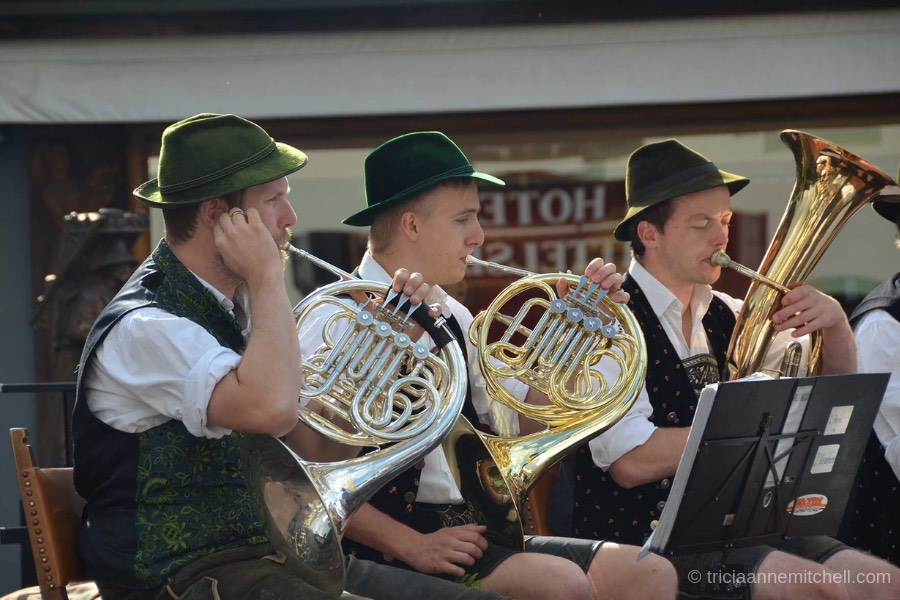



Hotels and Accommodation
Since it’s a beloved tourist destination, you’ll find a wide range of accommodation options in Oberammergau. There are tiny hotels, holiday apartments (Ferienwohnungen), and even properties that cater to pets.
Below, I’ve rounded up a few distinctive accommodation options. Please note that some affiliate links follow.
Historic Accommodation:
- Zum Kirchenbauer – Located just a stone’s throw from Oberammergau’s main church, the Kirchenbauer boasts a beautifully frescoed façade. The owners serve a hearty breakfast that’s made using fresh honey, dairy, and bread produced in the region. There is also a traditional tavern and wine shop on-site.
- Ferienwohnungen im Lüftlmalereck, Mussldomahaus – Built in 1690, the Mussldomahaus is believed to be Oberammergau’s oldest farmhouse. The front of this charming building is adorned with colorful frescoes, known in German as Lüftlmalerei. These colorful decorations were painted by a famous artist named Franz Seraph Zwinck. The Mussldomahaus holiday apartments have mountain views, as well as their own entrances. Guests are also allowed access to the garden.
- Hotel Alte Post – Dating back to the early 17th century, this famous hotel is widely believed to be one of Oberammergau’s oldest. The building’s façade features traditional frescoed painting, and there is also a popular Bavarian restaurant on-site.
- Dedlerhaus – Just across the street from Oberammergau’s historic church, this 18th-century property features a beautifully frescoed façade. Much of the interior is decorated with traditional Bavarian furniture. There’s also a terrace and on-site parking, and Oberammergau’s center is just a few minutes away on foot.
- Hotel Turmwirt – This three-star hotel has been run by the same family since 1934. The offerings include a gym, sauna, and breakfast buffet. Some of Turmwirt’s guestrooms even have mountain views.
Luxurious Properties:
- Hotel Maximilian – This design hotel marries spacious rooms, spa treatments, and the Maxbräu — a gourmet restaurant. The Maxbräu whips up Bavarian cuisine and even brews its own beer in handsome copper vats.
- Ferienwohnung in den Bergen – The interiors of these apartments are streamlined, with modern Bavarian touches. Units feature state-of-the-art kitchens. They also offer either a balcony or a terrace — perfect for savoring the property’s mountain views.
Cozy Apartments:
- Apartment Villa Asih – With an exterior resembling a gingerbread house, the Villa Asih is both charming and cozy. Several garden houses dot the flower-filled property, and there is also a fish pond. Oberammergau’s distinctive mountain, the Kofel, is visible from the Villa Asih gardens. The Hansel and Gretel House and Little Red Riding Hood House are just footsteps away.
- BergZeit – This two-bedroom home offers a terrace, sauna, the use of free bikes, and views of the Kofel.
- Ferienhaus Alpinissimo – With an outdoor pool, fitness center, sauna, and non-smoking rooms, the Alpinissimo is a haven for health-focused travelers. The property is located in a tranquil neighborhood and offers superb mountain views.
- Ferienwohnung Schauberger – Located near the Laber Cable Car station and the WellenBerg Pool, this apartment is south-facing and features mountain views. The owners also provide guests with the Königscard, which gives visitors free admission to various local attractions.
Pet-Friendly:
- Hotel Wolf – If you spend any time in Germany, you’ll quickly notice the German affinity for pets. To say that the Hotel Wolf is dog-friendly is an understatement, though! This property has indoor sports areas for dog training; a dog pool is even nearby. Rooms are outfitted with dog beds and pet bowls. Dog-training workshops are held here regularly and physical therapy sessions are available. There are even on-site dog showers to ensure your furry friend is properly bathed following a dip in the dog pool or the Ammer River. For humans (and the lucky pups who catch the table scraps), the Hotel Wolf features an on-site restaurant, too.
- Hotel Garni Otto Huber – Ski storage and a sauna make this hotel attractive to visitors coming to Oberammergau for winter sports. The hotel is family-owned and also offers free parking on-site.
- Hotel Wittelsbach Oberammergau – In addition to welcoming four-legged friends, the Hotel Wittelsbach also offers a breakfast buffet. It’s conveniently located in the heart of the town center, not far from Oberammergau’s museum and shops.
Spas:
- Parkhotel Sonnenhof – Overlooked by Mount Kofel, the Sonnenhof features a spa and indoor swimming pool. It’s also just footsteps away from the Ammer River — a scenic spot for strolling.
- Ferienhaus Fux – Boasting a spa and wellness center as well as a children’s play room, the Ferienhaus Fux also offers ski storage.
- Auszeit – Auszeit features a wellness area with a hot tub and sauna. There is also a sun terrace and garden, and guests can use the property’s bikes free of charge.
- Hotel Arnika – With free parking and an on-site restaurant, the Arnika offers convenience. The hotel features a spa and wellness center and a sun terrace with extraordinary views of the Kofel and Laber mountains.
Family-Owned Properties:
- Gasthof Zur Rose – Run by the same family for more than 70 years, the Gasthof Rose has 19 rooms and an on-site restaurant.
- Mammhofer Suite & Breakfast – Family-run for four generations, the Mammhofer offers an attractive garden. There are single and double rooms, as well as larger suites. The building’s exterior features traditional Bavarian architecture, but the accommodation’s interior has recently been restored.
- Haus Hannah – Owned by an English family that has made Oberammergau their home, the Haus Hannah offers a fully-equipped, self-contained apartment, as well as a family bedroom that is ideal for two adults and two children. The home is situated near a tranquil meadow, meaning that you’re likely to hear the meditative sound of cowbells during your stay.
- Gasthaus Richter – Conveniently situated near the train station, grocery stores, and Oberammergau’s center, the Gasthaus Richter features nine guest-rooms. The family serves some locally-sourced pastries, meat, and dairy products at breakfast.
- Hotel Antonia – This family-owned property features a Finnish sauna. The Hotel Antonia is also within convenient reach of the train station and the Passion Play Theater.
Youth Hostels:
- Jugendherberge Oberammergau – Located near the Ammer River near the base of Mount Kofel, this youth hostel has a variety of lodging options, including a mixed dormitory room, private rooms, family rooms, and more. The Jugendherberge Oberammergau is situated in a quiet area, near a gravel path that’ll take you to the center of Oberammergau in about 5 minutes. The property also has a ski storage room, laundry room, games room, children’s playground, an indoor climbing wall, and more.
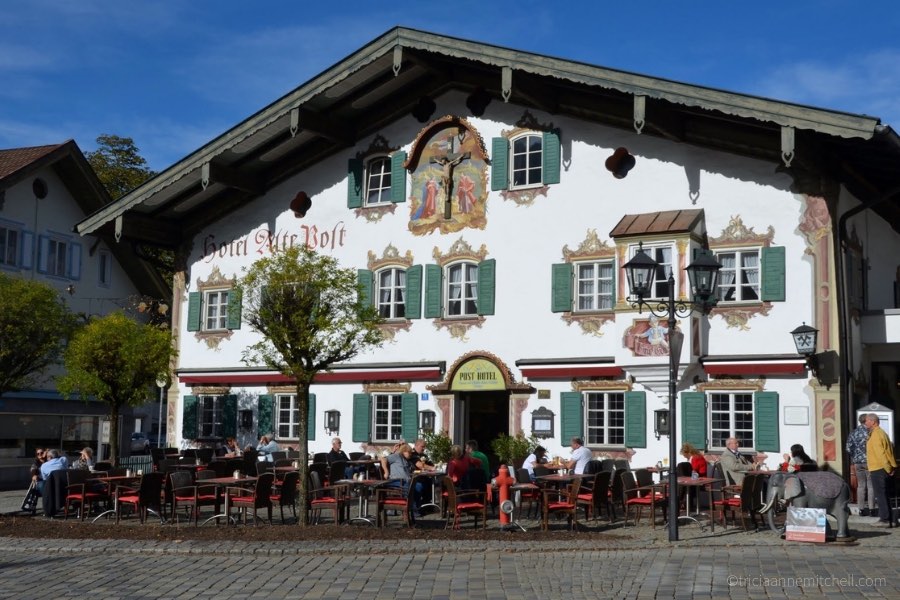
Bakeries, Cafés, and Restaurants
Bakeries
- Bäckerei Aurhammer: I eat gluten-free products, so I’ve never been able to partake in Aurhammer’s rustic breads or pretty pastries. My parents and husband, however, love the Aurhammer’s delightful selection of artisanal bread, its friendly staff, and pleasant, streamlined interior. Address: Dorfstrasse 30.
Spots for Coffee, Ice Cream, or Drinks
- Theatercafé: Has great coffee. They also used to serve some of the tastiest gluten-free pastries I’ve ever eaten. My favorite was the raspberry buckwheat cake with cream (photo of the mouthwatering cake below). After there was a change of management, there were unfortunately less gluten-free offerings on order. When I visited in the summer of 2021, they had no gluten-free cakes whatsoever. Here’s hoping that they’ll bring back the gluten-free cakes someday! Address: Othmar-Weis-Strasse 3.
- Ammergauer Maxbräu: With attractive indoor and outdoor seating options, the Maxbräu is a cozy year-round spot to grab a coffee, a glass of wine, or a mug of beer. Address: Ettalerstrasse 5.
- Alte Post: Situated on Oberammergau’s main intersection, the terrace of the Alte Post is a great place to savor a coffee and watch the world go by. Address: Dorfstrasse 19.
- Eiscafé Paradiso: Oberammergau only rarely experiences sizzling-hot temperatures, but when the sun’s out, this ice cream parlor is sure to be packed. The staff can let you know which ice cream varieties are gluten free. Address: Dorfstrasse 4.
Restaurants
German cuisine:
- Alte Post: Address: Dorfstrasse 19.
- Mundart: Address: Bahnhofstrasse 12.
- Ammergauer Maxbräu: Address: Ettalerstrasse 5.
- Zur Rose: Address: Dedlerstrasse 9.
- Zur Tini Weinstube: Address: Dorfstrasse 7.
Other cuisines:
- Dumpling und Sushi (Asian) Address: Dorfstrasse 15.
- El Puente (Mexican) Address: Daisenberger Strasse 3.
- Piccola Toscana (Italian): Address: Eugen-Papst Strasse 3a.
- Ming’s Wok (Asian): Address: Dorfstrasse 45.

Supermarkets and Special Dietary Needs
Despite being a small town, Oberammergau has several supermarkets. I have pinned them on the Oberammergau Map below. Look for the blue food symbol.
The following stores are conveniently clustered together, and are near the train stop (Bahnhof):
- Lidl: Germany’s omnipresent discount supermarket offers fruit and vegetables, meat, dairy, dry goods, frozen foods, and baked goods. Gluten-free bread, alternative milk (soy, oat, lactose-free), and some vegan options are also usually available. Address: Zur Lok 6.
- Netto: Another popular discount supermarket. Sells fruit, vegetables, meat, dairy, frozen food items, and dry goods. Gluten-free bread and alternative milk sources (almond, rice, oatmeal) are sometimes available. Address: Zur Lok 3.
- Edeka: A more upscale supermarket featuring fruit, vegetables, meat, dairy, frozen foods, and baked goods. Offers some international food items too, such as Asian noodles, etc. There are also gluten-free, vegan, organic food options here. Address: Rottenbucher Strasse 9.
- Müller: Sells cosmetics, household products, and some organic, non-perishable food items. In addition, you’ll find a small selection of gluten-free bread, lactose-free milk, vegan, and diabetic-friendly foods. Müller also has a machine for printing out digital photos. Address: Zur Lok 5.
Other stand-alone shops include:
- V-Markt: A supermarket and household goods shopping center. Sells fruit and vegetables, meat, dairy, dry goods, frozen foods, and baked goods. Address: Moosgasse 11.
- Bioladen Heidi: A tiny shop specializing in organic food and products catering to special dietary needs. Heidi also has natural cosmetics for sale. Address: Dorfstrasse 32.
Souvenirs
The center of Oberammergau is filled with shops, boutiques, and workshops that offer everything from woodcarvings to Christmas ornaments. Some products are mass-produced (and also sold at tourist destinations elsewhere in Germany), while other items are unique and produced in this region.
Oberammergau’s tourist office even sells a variety of merchandise, including vintage-style posters of Oberammergau and other regional products.
Below, I’ve broken down Oberammergau shopping ideas by category.
Common German souvenirs
- Carved, wooden objects – These are Oberammergau’s ubiquitous souvenir. Often, the subject matter is religious, but you can also find wooden toys and secular designs. Be aware that not all of the wooden souvenirs that you see in Oberammergau’s shops are made locally. (See the handcrafted section below for tips on how to find a keepsake that was crafted in this region.)
- Cuckoo clock (Kuckucksuhr)
- Beer mug (Bierstein)
- Christmas ornament
- Nutcracker
- Bavarian apparel such as Lederhosen or Dirndls (collectively called Trachtenmode)
Handcrafted keepsakes made in the Oberammergau area
If you would like to buy something unique and support local artists at the same time, consider buying items with the Ammergau Alps Arts and Crafts designation: Ammergauer Alpen KunstHandwerk.
In order for goods to carry this mark, they must meet several criteria. For example, a product must have been made in the Ammergau Alps, using raw materials from the region. Or, the artisan must demonstrate that the item has not been mass-produced.
For a list of where you can find these local artists and craftspeople, visit the Ammergauer Alpen KunstHandwerk website. Once you’re on the website, navigate to the menu and find the word Mitglieder, which means “Members” in German. They’re you’ll find a diverse range of artisans, including goldsmiths, painters, wood carvers, pillow-seamstresses, and jumping-jack sculptors.
Edible, local products
If you’d like to purchase a consumable souvenir from the region, be sure that you’ll be able to get it through your country’s customs checkpoint. If you’re not able to import the food item, perhaps you can enjoy the product on a picnic while you’re still in Germany.
Here are a few ideas of edible products that are produced locally:
- Honey
- Beer, liqueur, or tea from the nearby Ettal Monastery (site in German)
- Cheese from the nearby Schaukäserei Ettal (site in German)
Fair trade goods from around the world
The Weltladen, a fair-trade shop, is the place to go if you’re looking to buy a gift with international flair. What’s more, the goods here are sold at a fair price, helping artisans and producers in Africa, South America, and Asia earn a reasonable income.
You’ll find everything from coffee and chocolate to hand-woven clothing and musical instruments.



Transportation
Oberammergau is located about 95 km (60 miles) southwest of Munich. You can drive yourself to Oberammergau, of course. However, thanks to the area’s well-developed mass transit, it’s easy to get around without a rental car.
Oberammergau has a railway stop (Bahnhof), but it doesn’t have a staffed train station or dedicated building. Near the railway stop there are several railway kiosks / ticket machines. You can buy and print train tickets there.
Regional bus lines service the railway station, as well as a few other bus stops in town. If you’re an overnight guest in Oberammergau, you might even be able to use the regional bus or train network free of charge if your accommodation is part of the Königscard network. The Ammergau Alps Tourism website explains this free transportation benefit.
Here are a few helpful transportation links:
- Deutsche Bahn (DE), Germany’s Train Network – You can find timetables and ticket prices here. Tickets can be purchased online, and then either printed, or displayed on your mobile phone. You can also buy tickets from kiosks located at railway stations. They also have an app for your mobile device.
- Oberbayern Bus Network – Timetables and ticket prices are included on the site. You can also buy tickets directly from the bus driver.
- Flixbus also offers some connections to cities near Oberammergau.

Tourist Information Office
Address: Eugen-Papst-Strasse 9a
Oberammergau’s tourist office has informational brochures and staff who can answer your questions about the area. In addition, they sell souvenir items, including this 0-euro souvenir money, featuring Oberammergau’s famous Pilatushaus.
Here are the opening hours for Oberammergau’s tourist office.

Money and Tipping
Germany uses the euro (€) as its currency.
Many Oberammergau merchants, to include hotels and souvenir stores, now accept international credit cards. However, some businesses only accept EC (EuroCheque) cards, which have 4-digit pins.
Be forewarned that it’s still common to find businesses that only accept cash. We’ve encountered this at restaurants and in smaller shops. If you don’t have cash on hand, be sure to ask staff for clarification before you’ve committed to a meal.
Oberammergau has a few ATM machines (Geldautomaten):
- Sparkasse, address: Dorfstrasse 23
- VR Bank, address: Bahnhofstrasse 24
As for tipping, service costs are usually built into German restaurant prices. This means that tips aren’t generally expected. However, it’s still customary to round up. For example, if the bill was €8.20, you can hand the server a €10 bill, and say, “€9, please.” The server will then return €1 to you.
If you are especially pleased with the service, you can tip 10% — or whatever feels right. Note that if you’re paying with a credit card and you want to give something extra, it’s often best to pay the tip in cash.

Language Basics
Bavarians speak a dialect called Bairisch. The accent varies dramatically from what you’ll hear in other parts of Germany. Many Bavarian greetings and common words are even different from their standard German counterparts.
Even after living in Heidelberg for many years (a city that’s a few hours to the north), I still have a difficult time with the Bavarian dialect. Never fear, though, as you can still impress the locals if you learn a few Bairisch basics:
- Hello (formal) = Grüß Gott
- Hello (less formal) = Grüß dich
- Hello / Goodbye (casual) = Servus
- Cheers = Prost or Prosit
Finally, don’t get stumped by Germany’s “ß” letter, called the Eszett. You’ll frequently see it on street signs, as it’s another way of writing “ss.” For example, the German word for street is Strasse or Straße.

Pharmacies
The German word for pharmacy is Apotheke. Oberammergau has a couple of pharmacies, which I’ve pinned on the Oberammergau Map below. Look for the red pharmacy symbol.
Here are the pharmacies’ names and addresses:
- Kofel Apotheke, address: Ettalerstrasse 12
- Stern Apotheke, address: Dorfstrasse 5
Post Offices
Oberammergau doesn’t have a dedicated post office, but it does have Deutsche Post outlets inside private shops where you can mail letters and packages. I have pinned them on the map below using a green envelope symbol.
Here are the locations offering postal services:
- Ammergauer Getränkemarkt (offers Deutsche Post services), address: Rottenbucher Strasse 13
- Sporthaus Mühlstrasser (offers Deutsche Post services), address: Theaterstrasse 2
The cost to mail a letter can vary significantly if the dimensions of your envelope exceed certain limits. Reference these German Post domestic letter & postcard prices in advance to make sure you’re within the limits.
If you’ll be mailing something to an international destination, take a peek at the German Post overseas letter and parcel costs here.
Printing Documents
Digital copies of tickets and documents have become more widely accepted by German establishments in recent years.
If you need to actually print out a document, it’s likely that your hotel or apartment host can print if for you. If this is not an option, you can print documents at this shop:
- Buch und Bürobedarf Schwarz, address: Devrientweg 3. When I had something printed here in 2022, it cost €0.30 per sheet.
Day Trips from Oberammergau:
After you’ve gotten your fix of woodcarving and hiking, consider venturing out beyond Oberammergau. From palaces and castles to scenic gorges and more mountain towns, there’s a lot to explore in the region. And since it’s only about 95 kilometers (60 miles) from Oberammergau, Munich is never far away.

Ettal Monastery (Kloster Ettal)
The Ettal Monastery has long been a place of spiritual pilgrimage, but today, many people flock there for gastronomical reasons, too.
The monastery was commissioned by Emperor Ludwig the Bavarian in the 14th century. However, much of it had to be reconstructed following an 18th-century fire. The structure you see today is largely Baroque. Given the area’s humble architecture, the monastery feels grandiose in comparison.
Beer has been brewed in Ettal for more than 400 years. The monks also distill their own straw-yellow liqueur (Klosterlikör). You can sample both in Ettal.
What’s more, there’s a dairy cooperative just steps away from the monastery. Inside, you can watch cheese being made from locally-sourced milk. (When you encounter cows grazing during your Ammergau Alps hikes, be sure to thank them!) The cooperative also sells yogurt and butter. Products are said to be free of GMOs, and cheese varieties range from a “Fire Cheese” infused with garlic and paprika to “Beer Cheese.”
Ettal is about 5 km (3 miles) from Oberammergau, so it’s accessible on foot, and by bike, car, or bus.
Getting There:
Bus 9606 travels between Oberammergau and Ettal. The Oberbayernbus website displays current timetables. Navigate to the Oberbayern website and click on “Fahrplan,” then “Fahrplandownload.” Then input “9606” in the search bar. You can download a pdf of the schedule there.
More –
- Ettal Monastery (Kloster Ettal website)
- Ettal Dairy Cooperative and Showroom (Schaukäeserei Ettal website)
- Ettal Liqueur Manufacturing
- Ettal Monastery Brewery Museum
- A Peek at Germany’s Ettal Monastery (my blog post)
- Ettal Monastery: DailyDrone (drone footage from DW News)

Garmisch-Partenkirchen
The resort town of Garmisch-Partenkirchen is beloved for its dramatic mountain vistas and its active sports opportunities. Germany’s highest mountain, the Zugspitze, overlooks this idyllic town, which is studded with chalet-style buildings and lots of Lüftlmalerei. Garmisch-Partenkirchen is only 20 km (12 miles) from Oberammergau.
Garmisch-Partenkirchen (or GaP as it’s abbreviated locally) began life as two separate towns: Garmisch and Partenkirchen. In the 1930s, the two towns merged.
In 1936, Garmisch-Partenkirchen hosted the Winter Olympics. You can still visit the Olympic Stadium (Olympia Skistadion) today. If there is a sporting event taking place, you might even see adrenaline-seekers negotiating the nearby ski jump (Skisprungschanze).
The Partnachklamm Gorge — one of Garmisch-Partenkirchen’s well-known natural attractions — is not far from the Olympic Stadium. This gorge is 699 meters (2,293 feet) long, with walls that tower as high as 80 meters (262 feet) above the canyon floor. You can traverse the gorge throughout the year, unless harsh weather causes officials to close it for safety reasons.
Foresters used to transport logs through the Partnach Gorge, via the mighty Partnach River. When the logs got stuck, loggers had to be lowered into the gorge to dislodge them. In the 1880s, officials created a rugged path alongside the river. Eventually tunnels were channeled out of the rock, making the passage safer. In 1912, the gorge was opened to tourists.
During the spring months, the river rushes through the gorge. If you visit during the winter, you’ll probably spot stalactite-like formations of ice clinging to the rocks.
You can access the Partnachklamm via the Olympic Ski Stadium parking lot. The local bus even stops here, making it easy to explore Garmisch-Partenkirchen without a car. From the Olympic Ski Stadium, the walk to the Partnachklamm is about 30 minutes. Horse-drawn carriages will also transport you to the Partnachklamm entrance, for a fee.
Getting There:
Bus 9606 travels between Oberammergau and Garmisch-Partenkirchen. The Oberbayernbus website displays current timetables. Navigate to the Oberbayern website and click on “Fahrplan,” then “Fahrplandownload.” Then input “9606” in the search bar. You can download a pdf of the schedule there.
More –
- Garmisch-Partenkirchen Tourism (official website)
- Partnachklamm Gorge (official website) lists opening hours & ticket prices
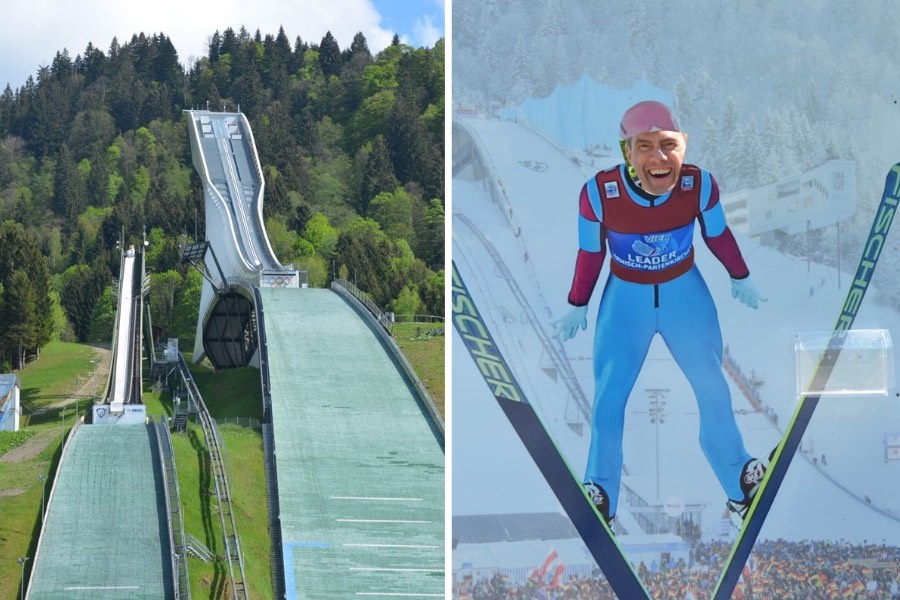

Linderhof Palace (Schloss Linderhof)
Of all the palaces King Ludwig II had constructed, Schloss Linderhof is the only one that was actually completed before his untimely and mysterious death.
Ludwig’s father, Maximilian II, originally had a hunting lodge here. Ludwig, however, was not fond of hunting, so he had his father’s lodge moved to another spot on the grounds. In the 1870s, Ludwig had the elegant Linderhof castle constructed.
Linderhof might be the smallest castle built by Ludwig, but there’s much more to appreciate here. The well-manicured grounds feature fountains, as well as imaginative outbuildings like the Moorish Kiosk and the Venus Grotto. The grotto is actually an artificial cave, outfitted with a lake, stalactites, and stalagmites. It is based on Wagner’s 1845 opera, Tannhäuser. Unfortunately, the grotto has been closed for renovation for several years.
If Linderhof’s French-style gardens and gilded interior have you thinking of Versailles, you’re on the right track, because Ludwig drew inspiration from Versailles and France’s “Sun King,” Louis XIV.
Linderhof Palace is not far from the Ettal Monastery. It’s about 14 km (9 miles) from Oberammergau.
Getting There:
Bus 9622 travels between Oberammergau and Linderhof. The Oberbayernbus website displays current timetables. Navigate to the Oberbayern website and click on “Fahrplan,” then “Fahrplandownload.” Then input “9622” in the search bar. You can download a pdf of the schedule there.
More –
- Linderhof Palace (Schloss Linderhof official website) lists opening hours & ticket prices
- A Peek at Linderhof Palace (my blog post)

Mittenwald
Not far from the Austrian border is the delightful town of Mittenwald. Like other communities in the region, Mittenwald is characterized by painted buildings and mountainous surroundings. What differentiates Mittenwald from the others, however, is its long tradition of violin-making.
Matthias Klotz introduced the art of crafting violins to Mittenwald in the 17th century. Today, you can learn more about this history at the city’s Violin-Making Museum (Geigenbaumuseum). Since several violin-making workshops still exist in Mittenwald, you can even step into a master’s workshop.
Afterwards, stroll past Mittenwald’s dollhouse-like homes, all the while watching your footing so as not to step into one of the town’s canals.
Mittenwald is 36 km (22 miles) from Oberammergau.
Getting There:
There are no direct buses from Oberammergau to Mittenwald, but getting there is easy. First, take bus 9606 from Oberammergau to Garmisch-Partenkirchen. Once you’ve arrived in Garmisch-Partenkirchen, take bus 9608 to Mittenwald.
The Oberbayernbus website displays current timetables. Navigate to the Oberbayern website and click on “Fahrplan,” then “Fahrplandownload.” Then input “9606” and “9608” in the search bar. You can download a pdf of the schedules there.
More –
- Mittenwald Tourism (Alpenwelt Karwendel)
- Mittenwald Violin Museum (Geigenbau Museum Mittenwald official website lists entrance fees & opening hours)
- Mittenwald: Mountains, Masks, Music, Mahlzeit! (Fotoeins blog post)

Neuschwanstein Castle (Schloss Neuschwanstein)
The world-famous Neuschwanstein Castle is located in Füssen, about 50 km (32 miles) west of Oberammergau. Like Linderhof Palace, this royal abode was commissioned by King Ludwig II. He actually grew up in the nearby Hohenschwangau Castle, which you can also tour.
Dubbed the “Sleeping Beauty” castle, Neuschwanstein is said to have been the inspiration for the Disney film of the same name. Construction for the romantic structure started in the late 1860s, but it was never officially finished. The name Neuschwanstein actually translates to “new swan stone.”
The Marienbrücke, an iron bridge built in 1866, is the place to go to capture postcard-worthy images of Neuschwanstein. It takes about 15 minutes to walk there from Neuschwanstein itself.
Getting There:
Bus 9606 travels between Oberammergau and Füssen. The Oberbayernbus website displays current timetables. Navigate to the Oberbayern website and click on “Fahrplan,” then “Fahrplandownload.” Then input “9606” in the search bar. You can download a pdf of the schedule there.
More –
- Neuschwanstein Castle (Schloss Neuschwanstein official website)
- An Autumn Afternoon at the Neuschwanstein Castle (my blog post)

Bad Bayersoien Lake and Natural Spa Park
The Soier See (Soier Lake) is one of southern Bavaria’s warmest lakes. This makes it a popular spot for swimming of course, but there’s much more on offer for nature lovers. You can rent boats, have a picnic, go fishing (with a license), enjoy refreshments at the on-site restaurant, or simply sunbathe on the wooden loungers.
A 2.5 km-nature trail (about 1.8 miles) wraps around this tiny lake. On the trail, you’ll find fallen tree stumps for balancing, wooden walkways, and sensory areas for massaging your bare feet. This makes the circuit a hit for both children and adults. You’ll also see your share of leashed, furry friends.
Finally, Bad Bayersoien is known for the Moor that is extracted from its bog landscape. This peat-rich mud is said to have therapeutic qualities. You can immerse yourself in this dark chocolate-like substance in the moor wading pool, which is adjacent to the lake.
Getting There:
Bad Bayersoien is located 15 km (9 miles) from Oberammergau.
Bus 9606 travels between Oberammergau and Bad Bayersoien. The Oberbayernbus website displays current timetables. Navigate to the Oberbayern website and click on “Fahrplan,” then “Fahrplandownload.” Then input “9606” in the search bar. You can download a pdf of the schedule there. Note that the Eisplatz bus stop is the one that is closest to the lake.
More –
- Soier Lake (Ammergauer Alps Tourism website)

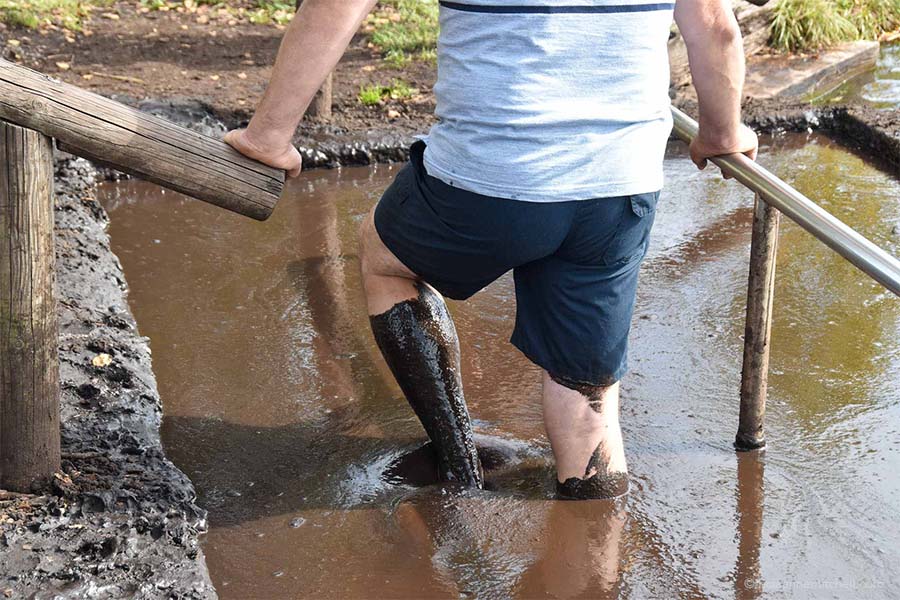

Oberammergau might be a tiny town, but as you can see, there are lots of things to keep you busy in the area.
If you have any questions as you plan your trip, feel free to let me know. Here’s wishing you a pleasant stay!
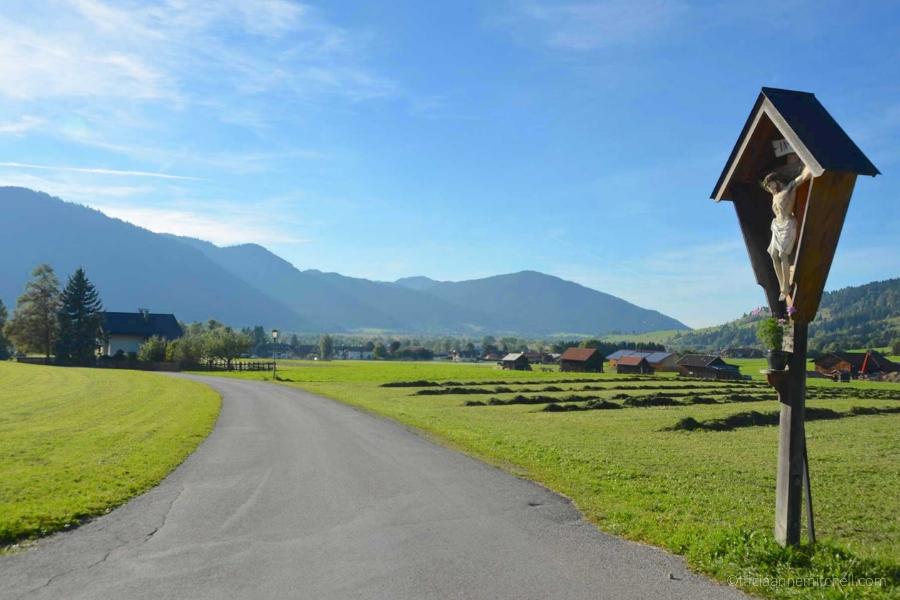
Where in the World?
Save to Pinterest
Photography & text © Tricia A. Mitchell. All Rights Reserved.
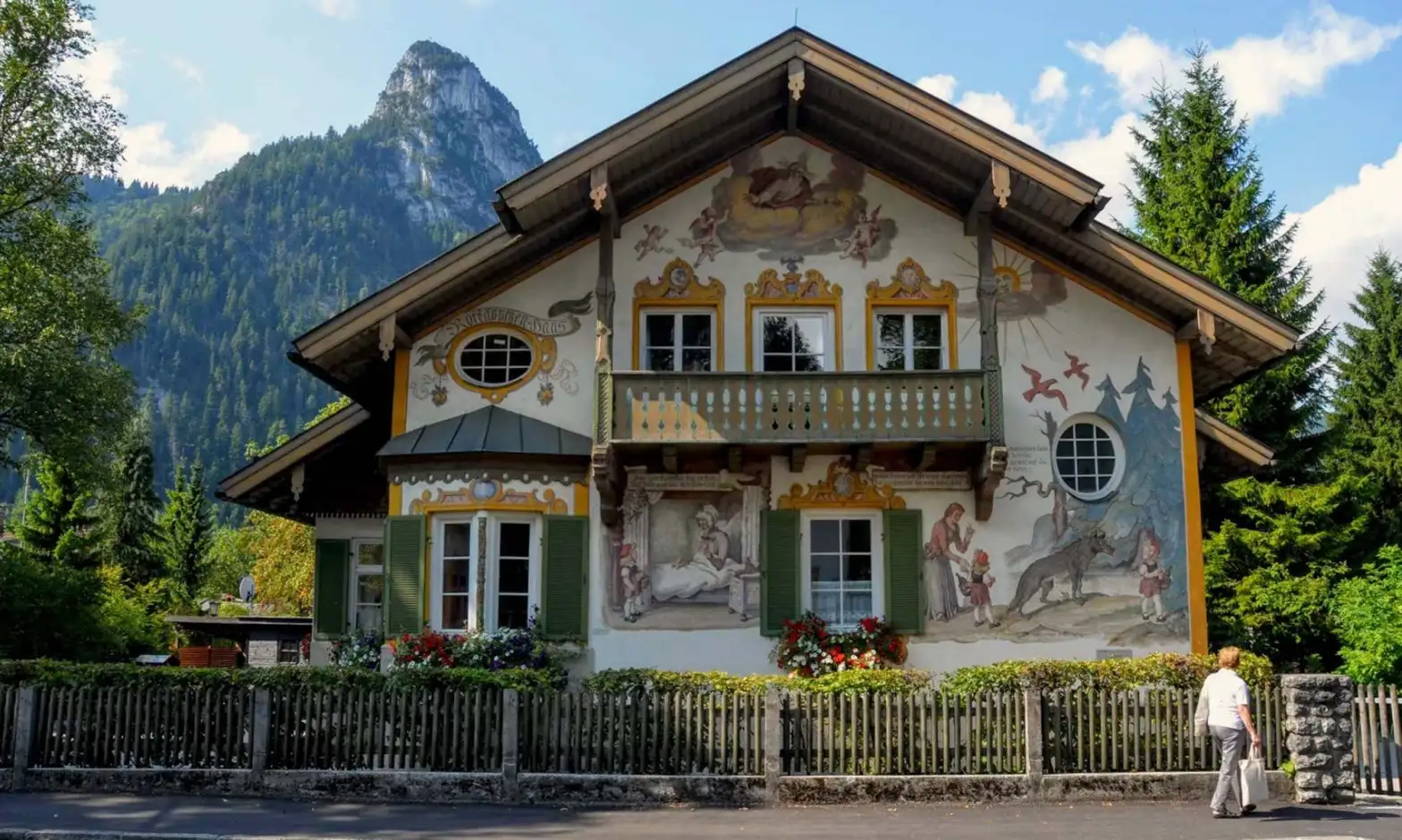
Wow, what a beautiful and colourful place to explore! Those mountain views are absolutely amazing and as a Brother Grimm fanatic I would love to visit one day. Thanks for sharing
Hi Aiva, Ericeira, and Valters,
Glad you enjoyed this peek at Oberammergau. Indeed, those fairy tale houses with the Brothers Grimm scenes are some of Oberammergau’s most beloved. I think it’s fitting that they’re being used for youth programs today.
Thank you — *Paldies — for reading, and here’s hoping you’ll make it to Bavaria someday soon!
(* It’s been a few years since I’ve been in Latvia, but my parents and I thought Riga and its Art Nouveau architecture was fabulous.)
Hi Tricia,
We really enjoyed reading your guide on exploring O’Gau. We’d love to visit there sometime. It’s just such a beautiful place.
Are you still there with your parents?
I hope you and Shawn are doing well. I loved his video also. Always great to hear from you and see your work.
Hope you have a wonderful Holiday season this year wherever your travels take you. 🍷❤️
Be well,
Fran and Dave
________________________________
Fran and Dave,
It’s wonderful to hear from you! Shawn and I hope you’ll be headed back to Europe soon and that our paths will cross. We’d love to hear about your adventures in Portugal’s Douro Valley.
I know you two like outdoor activities, so I can imagine you hiking in Oberammergau and Upper Bavaria. Oberammergau’s scenery is photogenic year-round, but I like it best when it’s warm and we can hit the trails.
As for us, we’re now in Georgia (the country). Hugs to you!
Hi Tricia, it’s so wonderful to see you here again with this grand post about O’gau, It makes my heard throbbing seeing all those images, as you know I’m originally a Bavarian. Many places I have seen and love, yet I learned a lot about things I didn’t know about O’gau. The Kofel, I would see from it’s other side from my aunts house, when I used to visit her years ago. I truly enjoyed everything in your post and thank you for taking me on a memory lane.
Hi Cornelia,
It’s wonderful to be in touch with you again and to imagine the O’gau that you came to know when you were a child. Also, I hope I haven’t made you homesick for Bavaria! Do you have plans to head back for a visit?
Shawn and I went to the Partnachklamm earlier this year, and as we walked by the Olympic Stadium, I thought of you. As I recall, your parents met at the Olympics there, didn’t they?
Have a wonderful weekend!
Hi Tricia, OMG you have a good memory, about my parents meeting in the train to the Olympics in 1936, I was touched that you were thinking of me, thank you so much for your kindness. No worries, a little homesickness is okay with me. No plans at the moment to visit Germany in the near future, but never know, what the future has in it’s magic bag for me. So great to hear from you , thank you. Enjoy your time where ever you are right now.
It sounds like there’s an incredible story behind their meeting, Cornelia. Did they every write the details in a journal? I wonder how far apart they lived from one another at the time, and how long it took for them to reunite? It sounds romantic.
I do hope that the “future’s magic bag” offers us a chance to meet up someday soon. We’re in Georgia (the country) right now, but perhaps our paths will intersect in Germany in the near future. Enjoy the rest of your weekend, and greetings to Moshu!
Thank you dear Tricia for your kind respond. Well it’s all documented by stories and B/W pictures, which I have kept after my mom passed. My mother is from Koenigsberg, Prussia than, and my father born in Nuernberg, it took them many years to finally reunite, long story there.
I hope so too, that at some point our paths will cross somewhere on the globe. Thank you so much for greetings to Moshu, wow, you have really a great memory, to remember my cats name. Wishing you a great time in Georgia. It’s really wonderful to stay in touch with you. Thank you my friend
Hi Tricia, welcome back! This post has so much information and it will be invaluable if ever we make it there again. Last time we just drove through on a local bus.
Thank you, Carol. Life has a funny way of leading you back to places, so perhaps you will end up in Upper Bavaria again. I actually visited Oberammergau twice — and then my parents ended up moving there.
What did you visit when you were in the region?
We stayed in Garmisch for several days. The day we travelled through Obermmergau we were on a local bus to Neuchwanstein.
Hi Tricia,
Your post has perfect timing for me! We are taking a group to Germany next year that includes the Passion Play.
We are planning additional touring on our own prior to the tour group and do have some questions especially coming from Austria. Since the tour includes Oberammergau and Neuschwanstein I’d like to plan a day in the area coming from Innsbruck and stopping in Mittenwald and maybe Linderhof and anything else you recommend as we make our way over to Strasbourg. meetyouinthemorning@aol.com
Merrill, I’m glad to hear that this guide to Oberammergau arrived at the perfect time for you.
If, by any chance, you’ll be using mass transit in Austria and Germany, do look into some of the special regional tickets (day passes, and so on), which each country offers. Sometimes the offer even extends into a sliver of the neighboring country, making for some good deals. Here are Germany’s regional day tickets for the railway: https://www.bahn.com/en/view/offers/regional/regional-day-tickets.shtml
As for trips between Oberammergau and Strasbourg, the pretty university town of Heidelberg is about 1.5 hours out of your way, but I think it’s a worthwhile stop. I lived there for 10 years, so I’m certainly biased. :) Here’s a post I created for Heidelberg, which gives you a feel for the city: https://triciaannemitchell.com/2015/06/21/things-to-do-heidelberg-germany/
Along your route is Baden-Baden, an elegant spa town (we have yet to do a spa day there). Further afield, the Alsace wine route has some beautiful villages — especially if you’re there as the leaves are turning and the harvest is taking place. Germany’s Black Forest (Schwarzwald) is also a pleasant area. So much to see, hope you have a fantastic time!
Thanks for the excellent post. I’m going to share it on TripAdvisor to help other tourists. I just booked tickets to the Passion Play next June and was hoping to find info. on the best painted houses and their addresses and you have made it possible for me to make a walking map for when we’re there. I hope you can help me with some miscellaneous questions. We’ll arrive in Oberammergau after driving from Fussen and touring Linderhof Palace and Ettal Abbey. About how much time will we want to allot to each of those places? Where is the best place to park our car that will allow for easy retrieval after the play since we’ll be spending the night in Garmisch-Partenkirchen and I’d like to get a head-start on all the other tourists? Are there free car parks or on-street parking? What would be the best options for a quick lunch? I’d even be fine with sandwiches at a supermarket or butcher like someone on TA mentioned if I knew where to look for one. The next morning I want to hike the Partnachklamm and get there around 8 am to beat the crowds. About how long will it take to hike from the Ski Jump, through the gorge and back to our car? After hiking the gorge I want to go up the Zugspitze but my husband thinks it’s way too expensive. Is it worth it? I know there’s also a cheaper option to ascend it from the Austrian side which would involve more driving. Have you done either one? Any suggestions on saving time doing this since we’re then driving almost 2 1/2 hours to tour Herrenchiemsee New Palace before arriving in Salzburg that night? I just want to make sure that whatever we do, it provides great photo ops.
Hi Kerry,
I’m happy to hear that this post has been useful to you so far, and thanks for your compliments! You must be excited about your upcoming trip. Will it be your first time to Germany?
It’s been years since we’ve driven to the places you mentioned, because we use the bus/train whenever we are visiting Bavaria. The public transportation is quite good, and we were able to get to many places (Schloss Linderhof, Neuschwanstein, Ettal, Garmisch, and Mittenwald, Salzburg, for example) using mass transit. However, I’m guessing that your time is limited, so I can see the allure of having your own wheels. I haven’t been to all of the destinations you’re hoping to visit (such as Zugspitze, Herrenchiemsee), but I’ll do my best to help.
When I did have a car in Germany for 10 years, I came to realize that paid parking is pretty much the norm. It’s most common to either park in a parking garage by the hour, or to pre-pay for outdoor parking by getting a Parkschein receipt from a meter (called a Parkschein Automat), which you then display on your car’s dashboard. Occasionally, you’ll find parking where you can park for free for a designated amount of time. In that case, you place a plastic clock on your dashboard, indicating your arrival time. Officials do monitor whether or not your time is up, so you’ll want to be sure you’re in compliance so you don’t get a traffic ticket. Since you’ll be driving, here are some generic parking tips: http://www.gettingaroundgermany.info/parken.shtml
As for Linderhof, they do have a large parking lot that’s not a far walk to the palace grounds. Linderhof’s official website mentions that there is a fee to park there, but the site doesn’t specify the amount. See here: https://www.schlosslinderhof.de/englisch/tourist/howtoget.htm
Likewise, Ettal has several paid parking areas. On Ettal’s Google listing, I see that the fee was anywhere from €2-4.
Regarding parking in Oberammergau during the Passion Play in 2010, there were free parking lots outside of town in which attendees could park. Those guests could then take a free shuttle to the Passion Play Theater and back. Since O’gau is a tiny town, I’m guessing they’re wanting to control the flow of traffic and that they’ll do something like this in 2020.
You also asked about food. I wasn’t sure if you meant where you can grab something to eat during the Passion Play intermission? It sounds like you purchased individual tickets (without accommodation or a meal option). If you want something inexpensive and fast, pop into any of the in-town bakeries (search for Bäckerei Oberammergau on Google Maps) or the supermarkets detailed in this post to grab something pre-made. The outdoor döner kebap stand near the supermarkets might be a good option too. I imagine some restaurants might be capitalizing on the Passion Play by offering convenience food options, as well.
As for how much time to devote to Linderhof and Ettal, that’s tough to say because every traveler has different interests! An hour was enough time for us to take in the architecture of the monastery, but if you want to go to the cheese showroom or do the brewery/distillery tours, I’d recommend allowing more time. See: https://www.kloster-ettal.de/oeffentliche-fuehrungen/ (in German). Linderhof’s grounds and all of the palace out-buildings are also worth a peek, and I could personally spend a few hours there. Note that King Ludwig’s grotto has been closed for renovation for a few years, and the website says it’s not slated to re-open until 2023.
Finally, as for Partnachklamm, I recall it taking about 25 minutes to walk from the Ski Jump to the entrance/ticket booth. From there, the time to walk all the way through the gorge depends on how many other people are in front of you and how quickly you walk and take photos. Keep in mind that it can be wet and slick in some sections. As I recall, it took at least 35 minutes to get through the gorge, one-way. But that doesn’t take into account the time we spent enjoying the scenery on the other side.
And speaking of photo opportunities, much depends on the weather! Since this area is mountainous, it can be rainy and grey at times, even during the summer months. I wish you sunny days during your June visit, as the region is absolutely stunning when the weather is cooperative.
What fabulously well-laid out advice on Oberammergau! I wish all guides were as thorough.
Thank you, Atreyee! I enjoyed putting this guide together — especially since it pushed me to explore some of Oberammergau’s lesser-visited spots.
Thank you so much for this post! Our family is taking a driving tour across Germany (from Prague to Zurich) and through my research of “quaint German villages” I found your post which has placed O’gau on the map for us!
Hi Jennifer! Wow, a roadtrip from Prague to Zurich sounds fun. Were you living in Prague or visiting? It’s one of my favorite cities. My piano teacher was born there in 1900, and she shared many stories about the city when I was growing up. :)
As for Oberammergau, I’m happy to hear that you’re headed there; thanks for letting me know. Are you making a visit this summer, or later in the year? Feel free to get in touch if you have any questions.